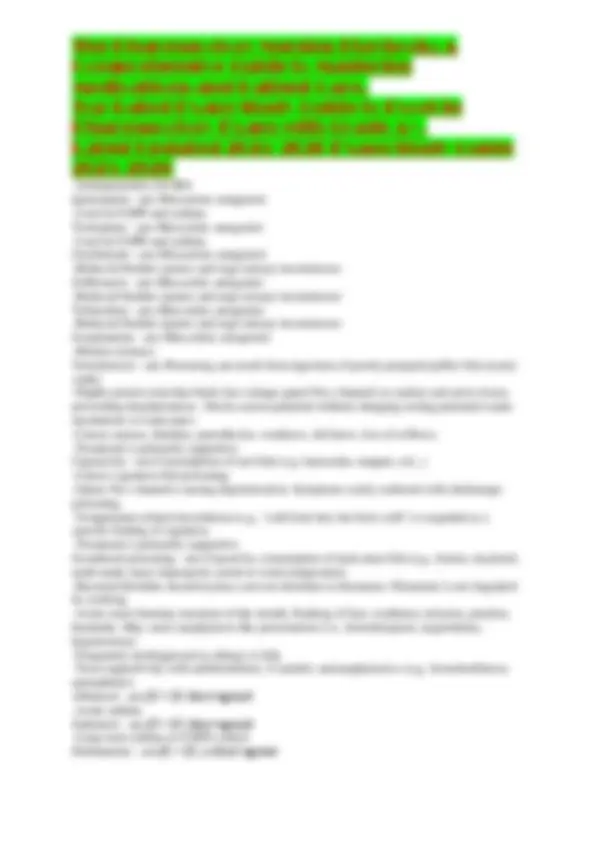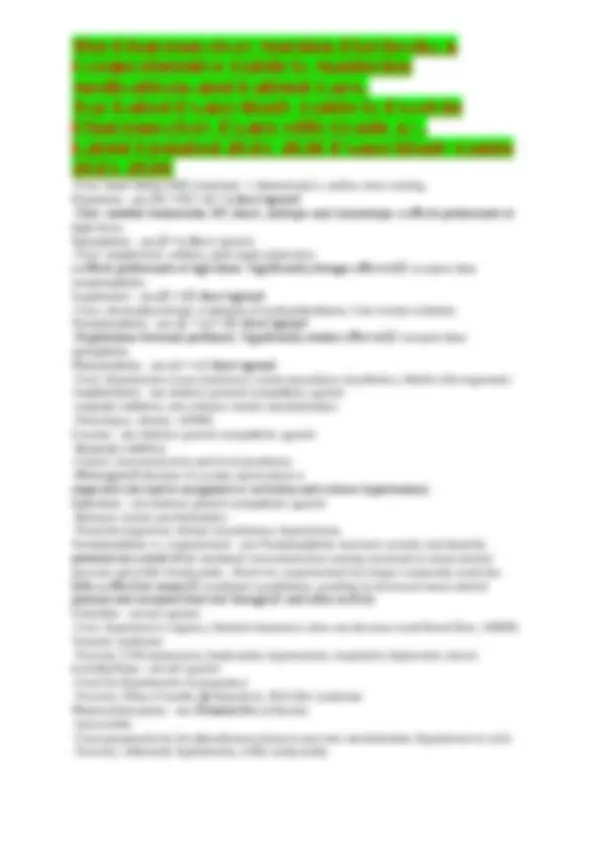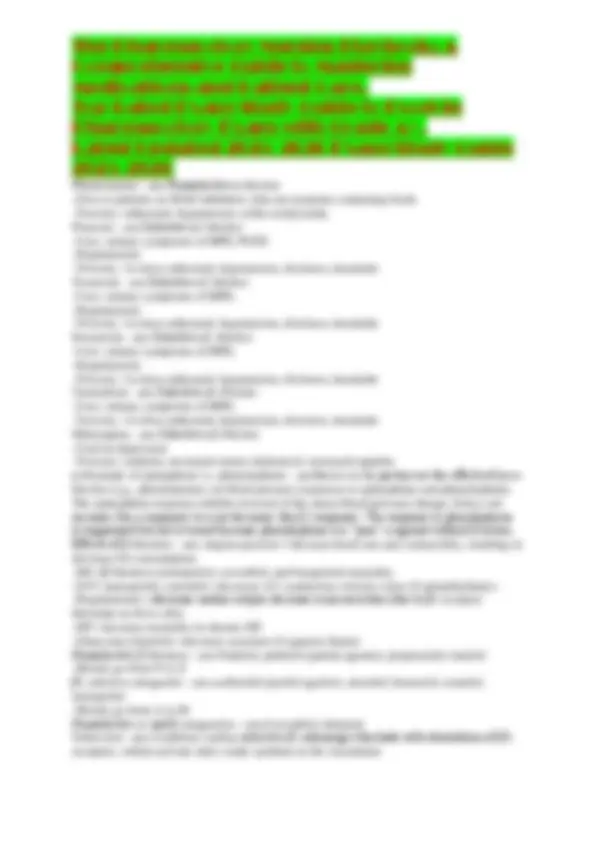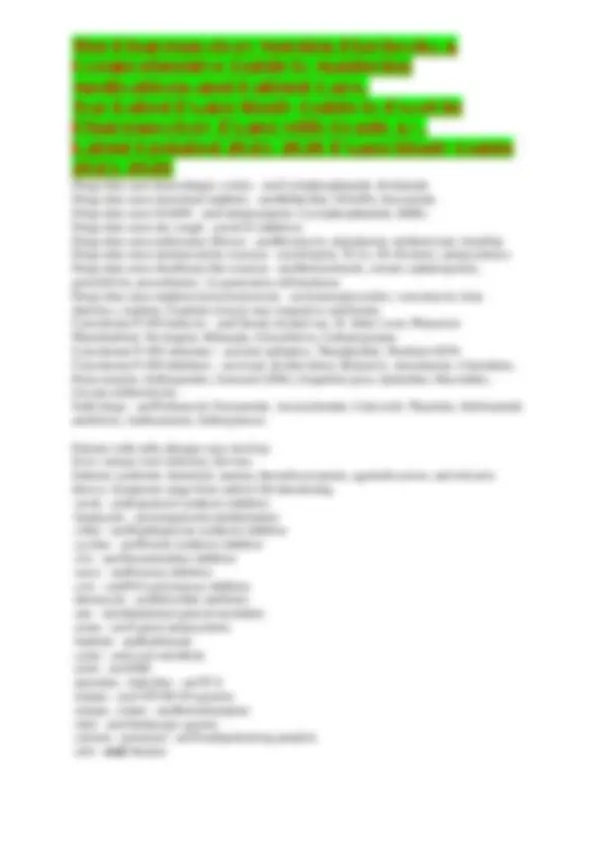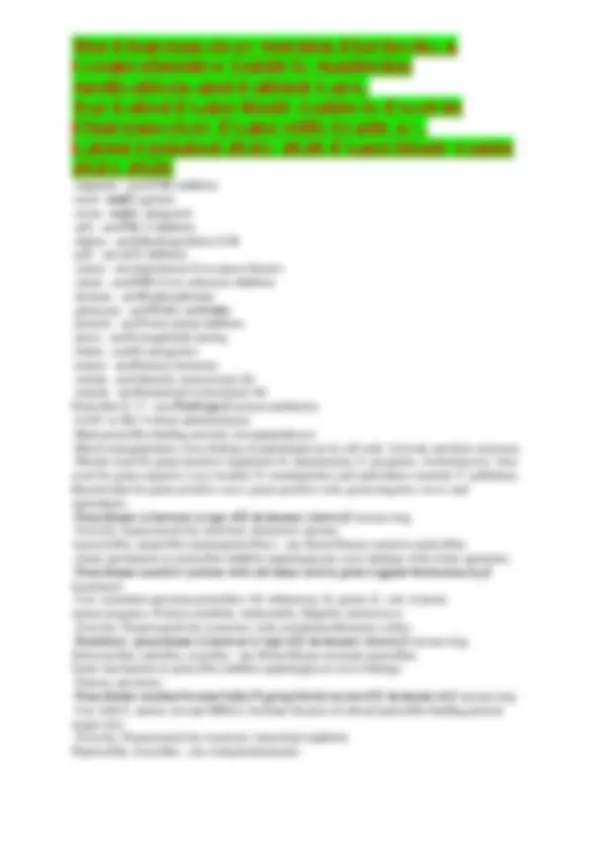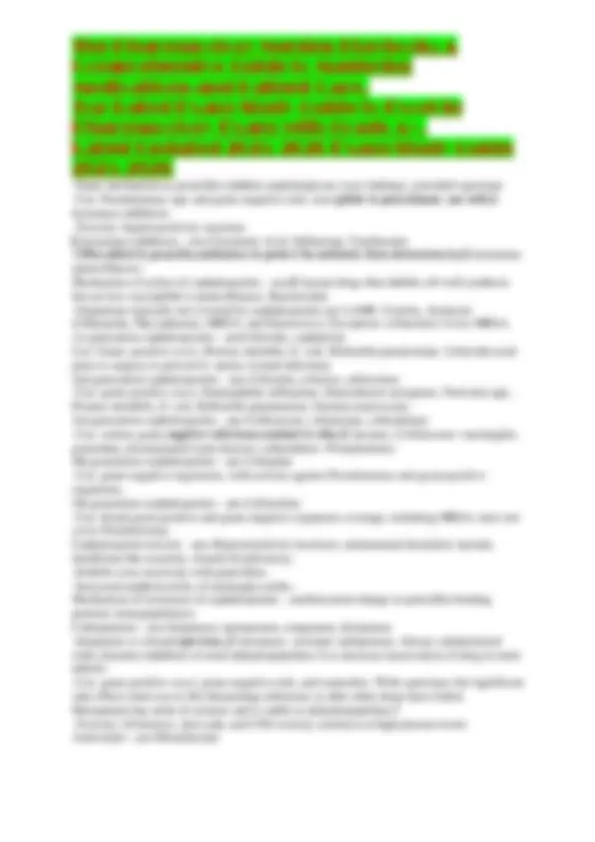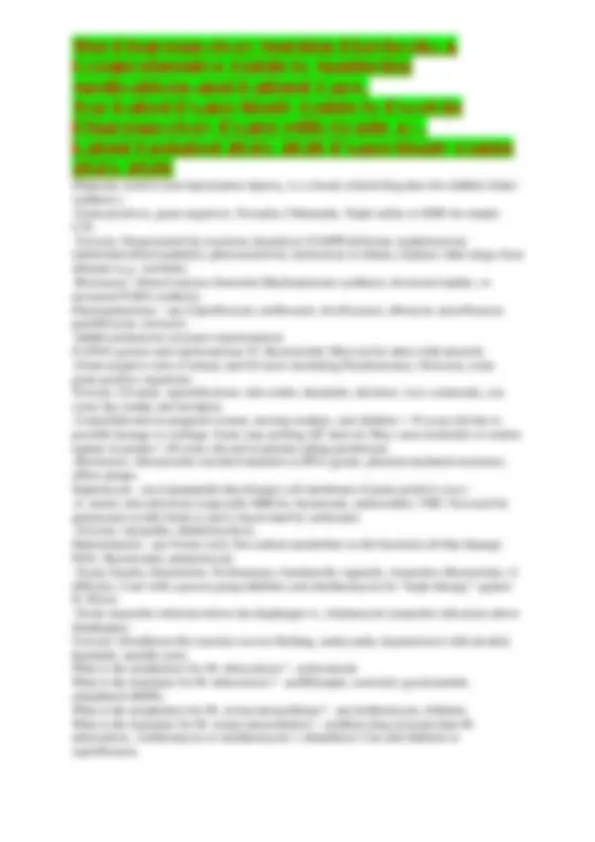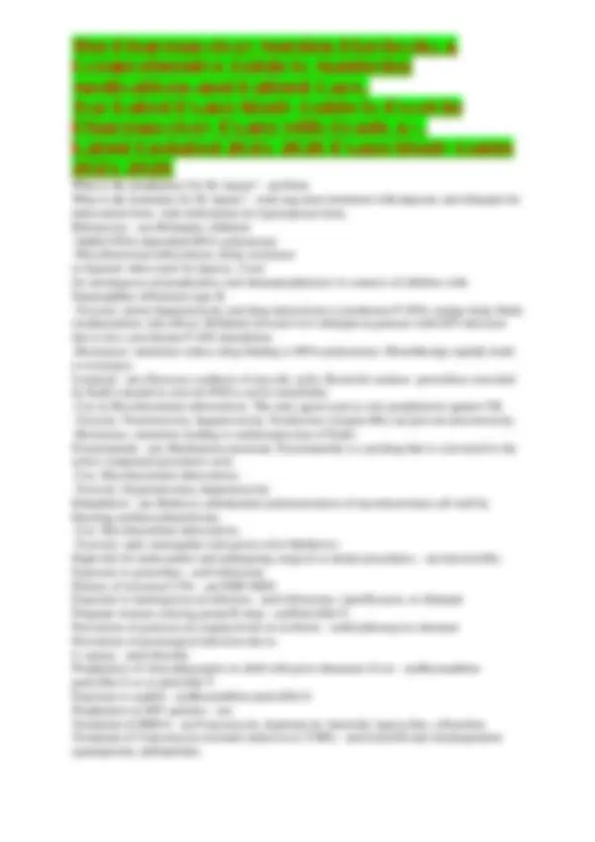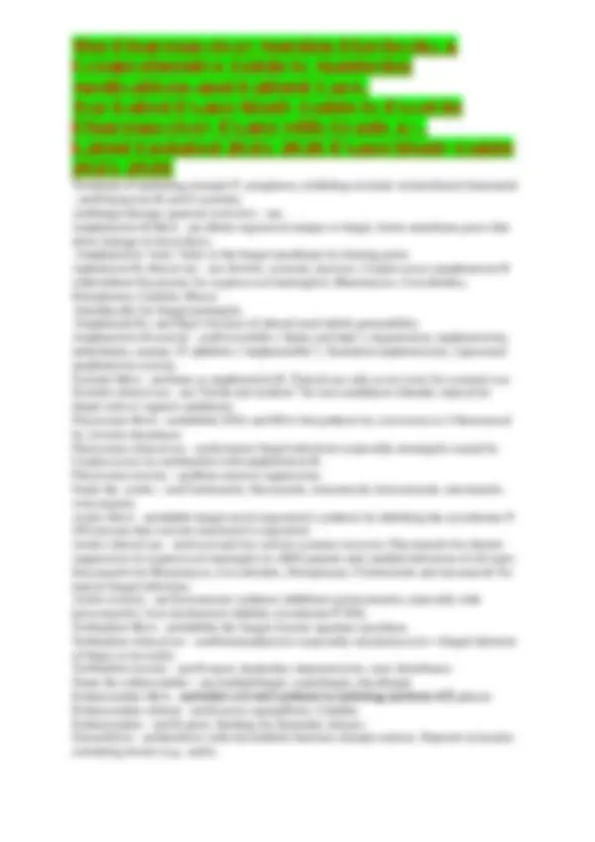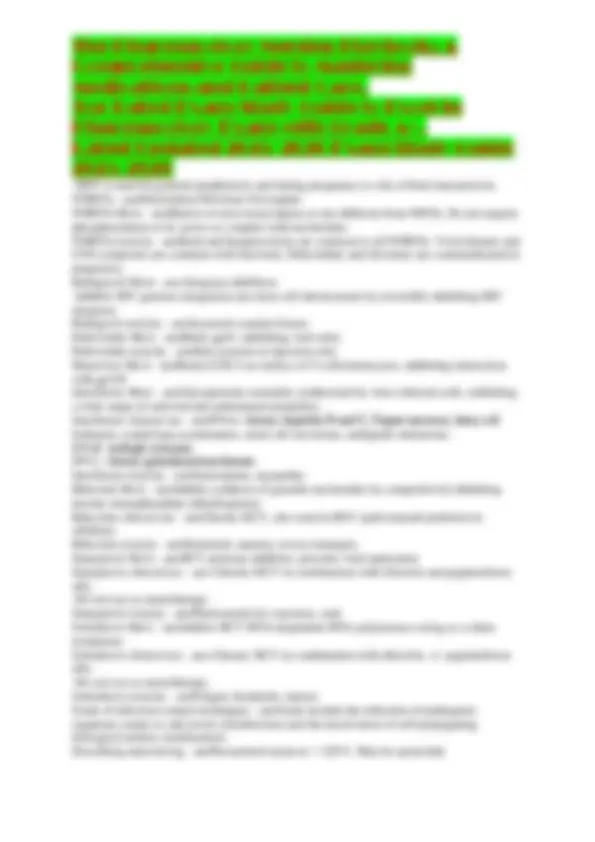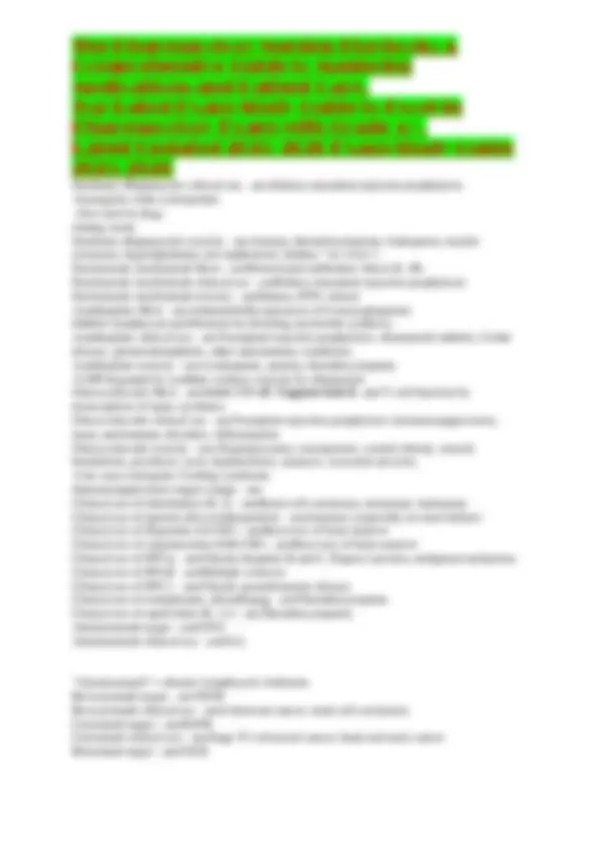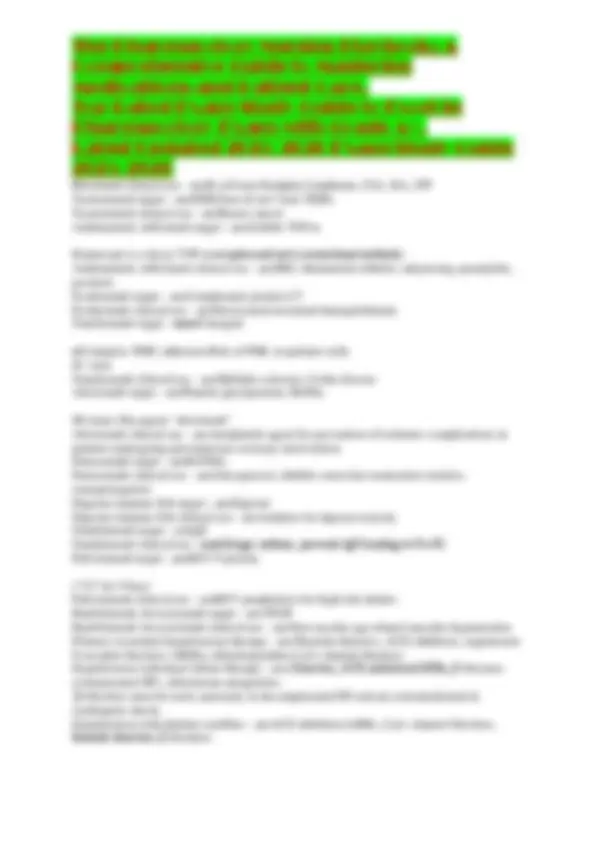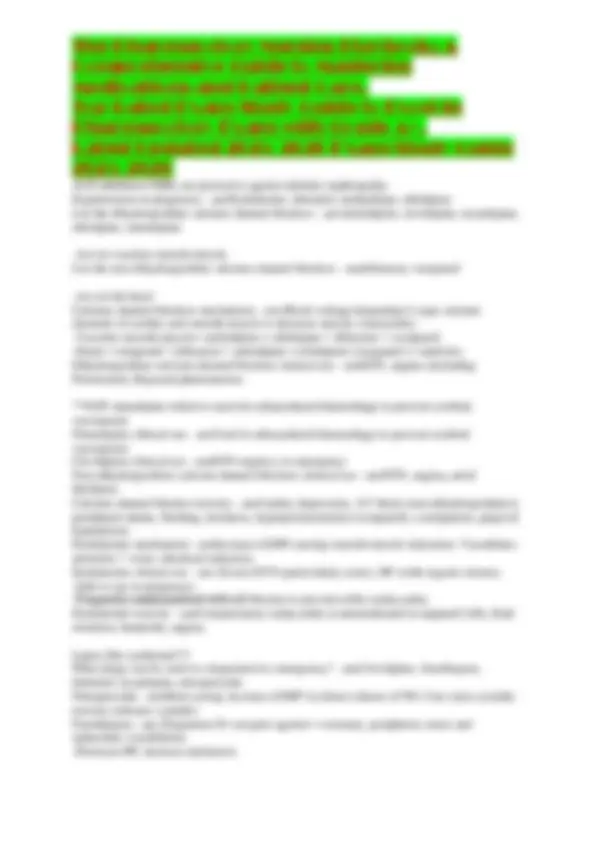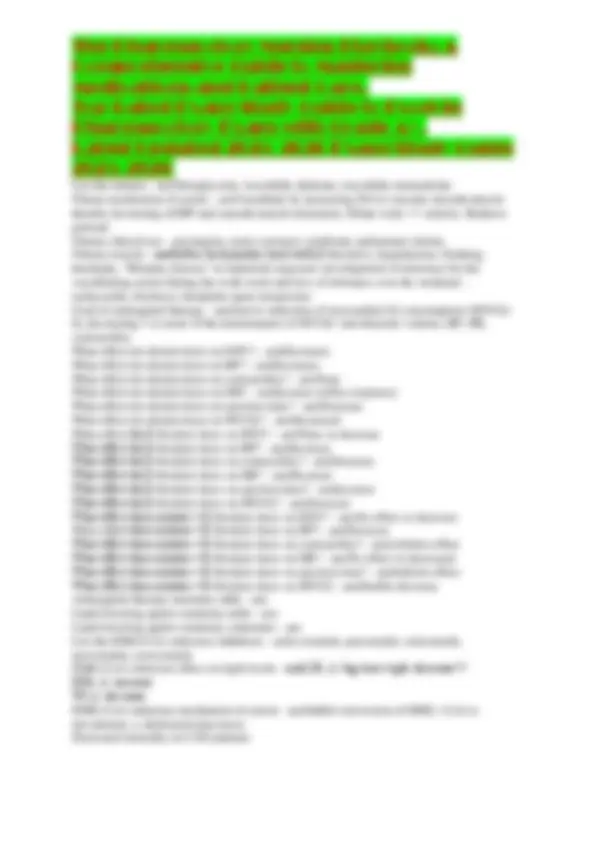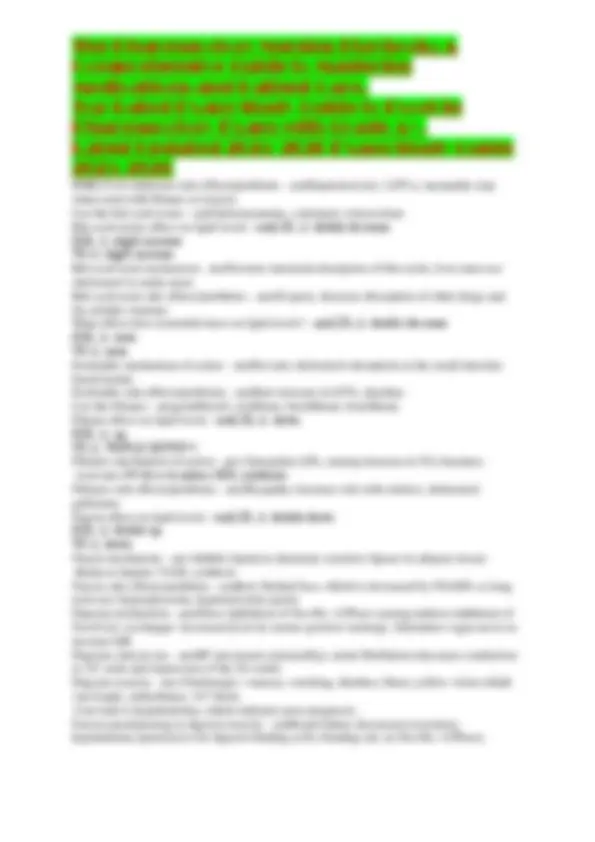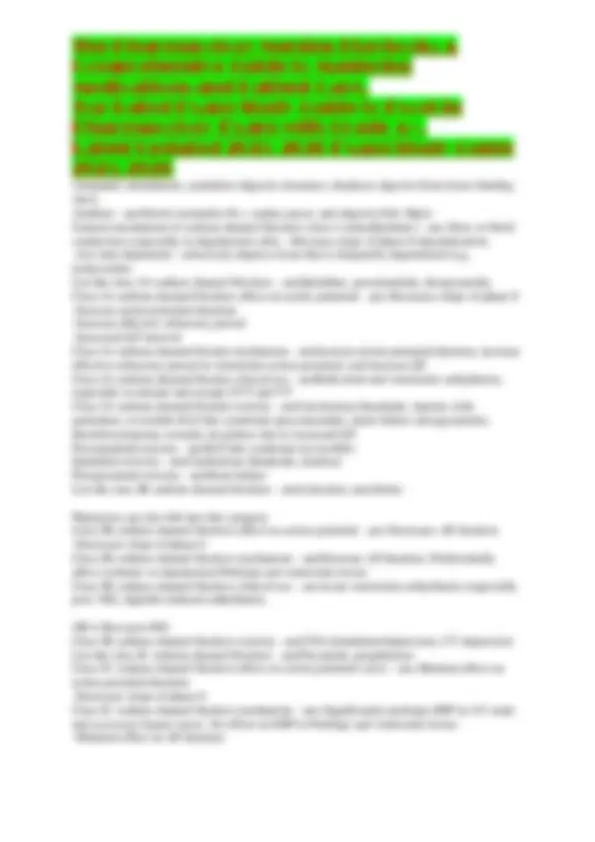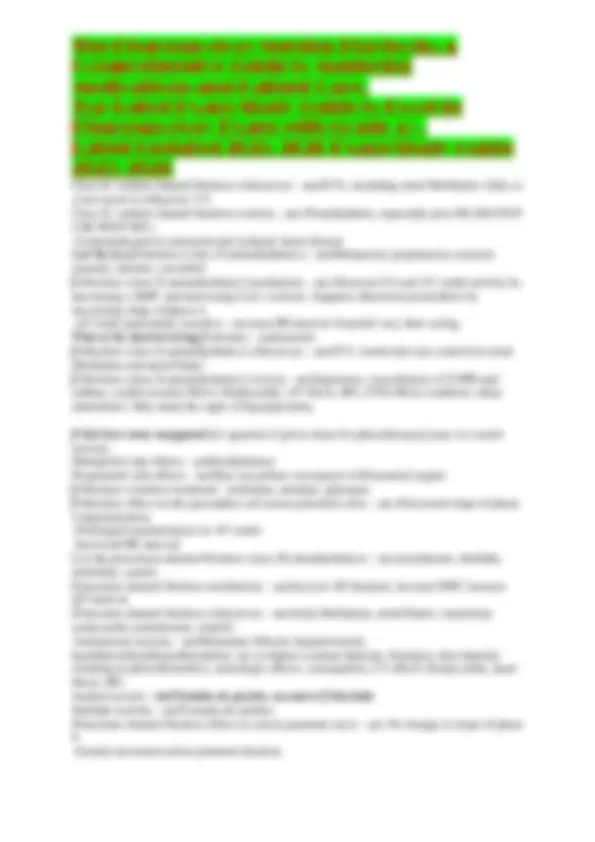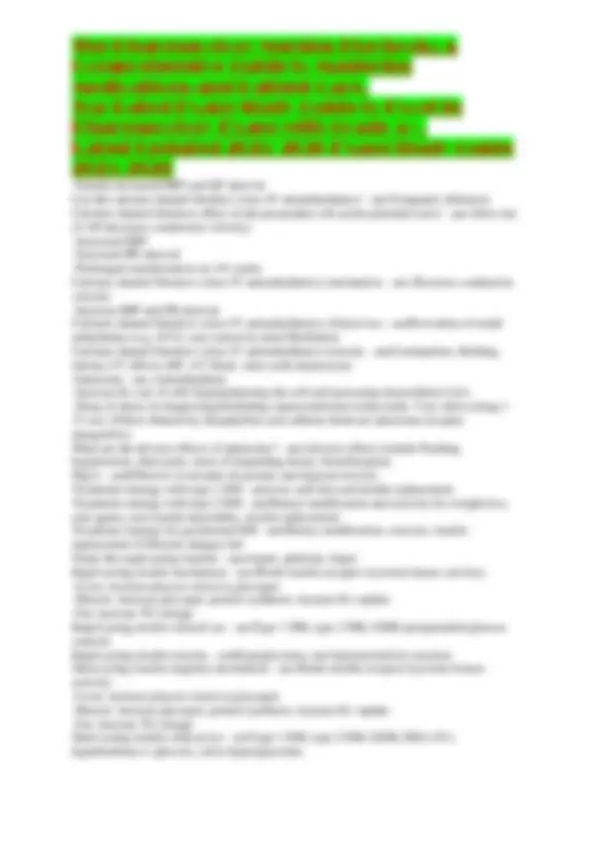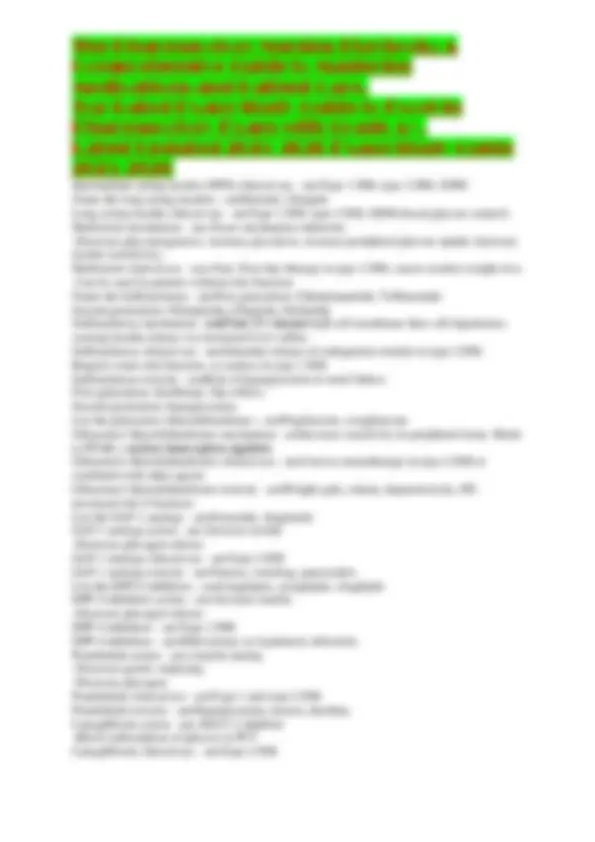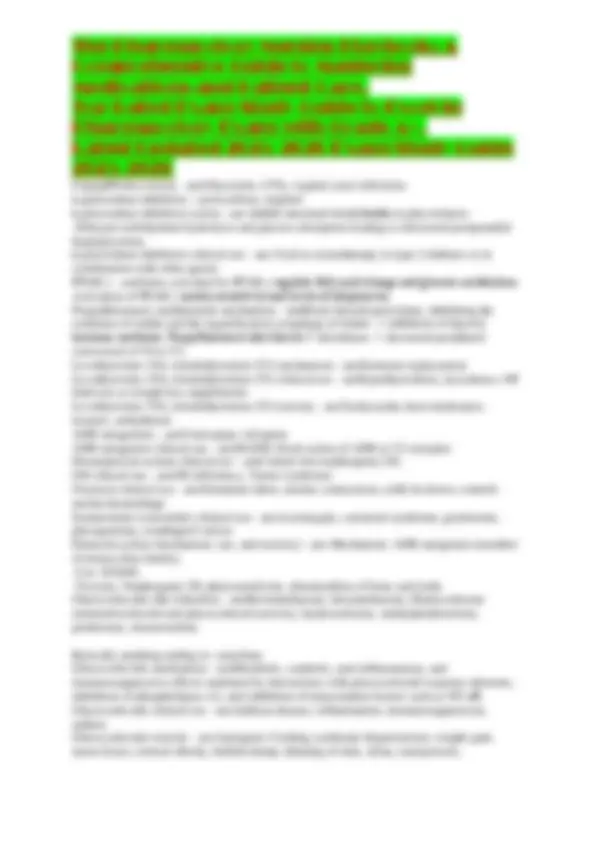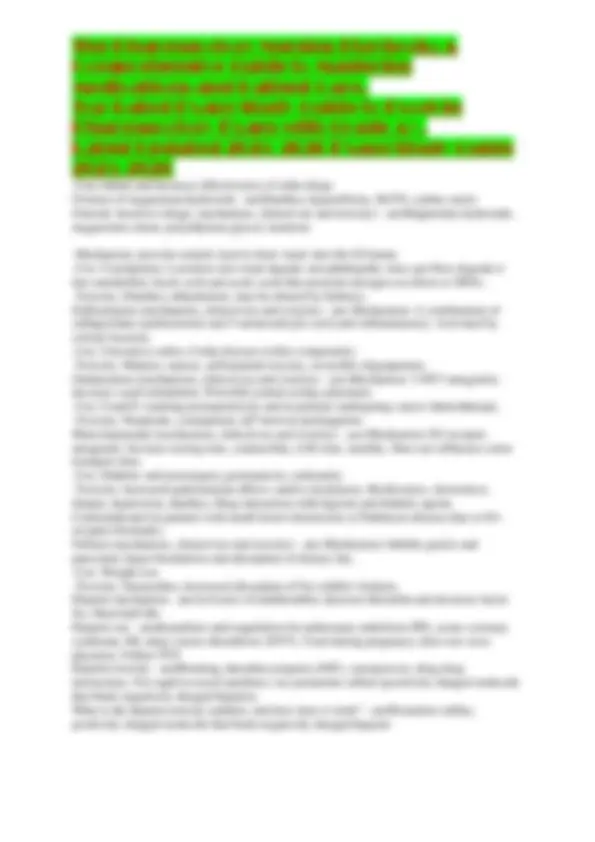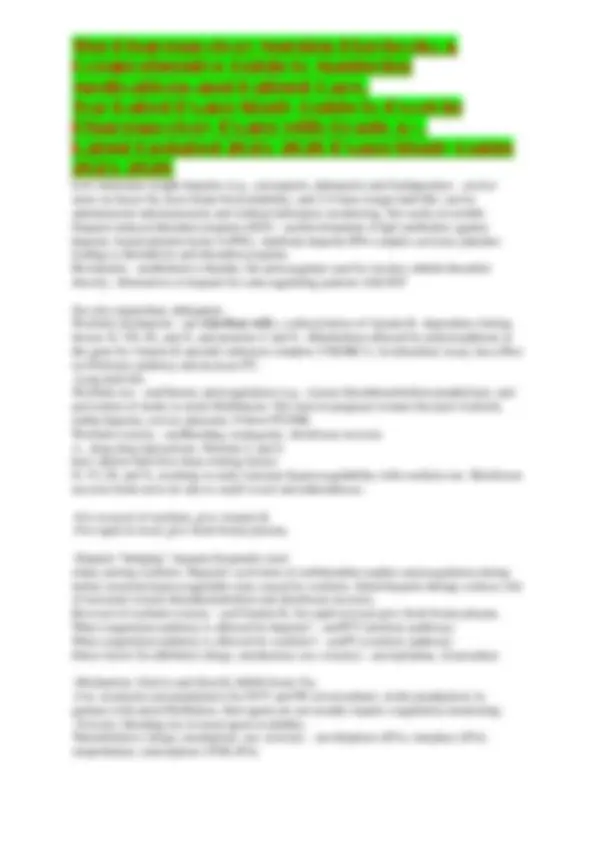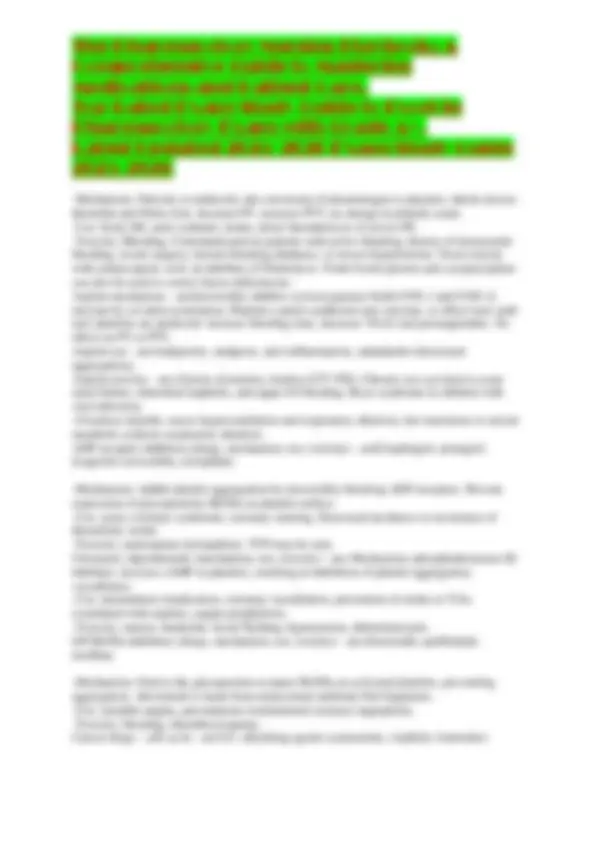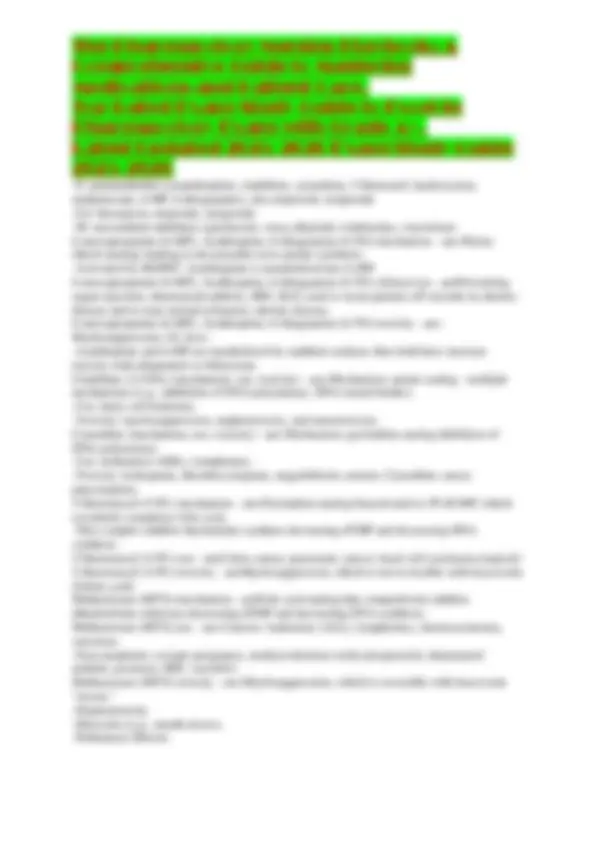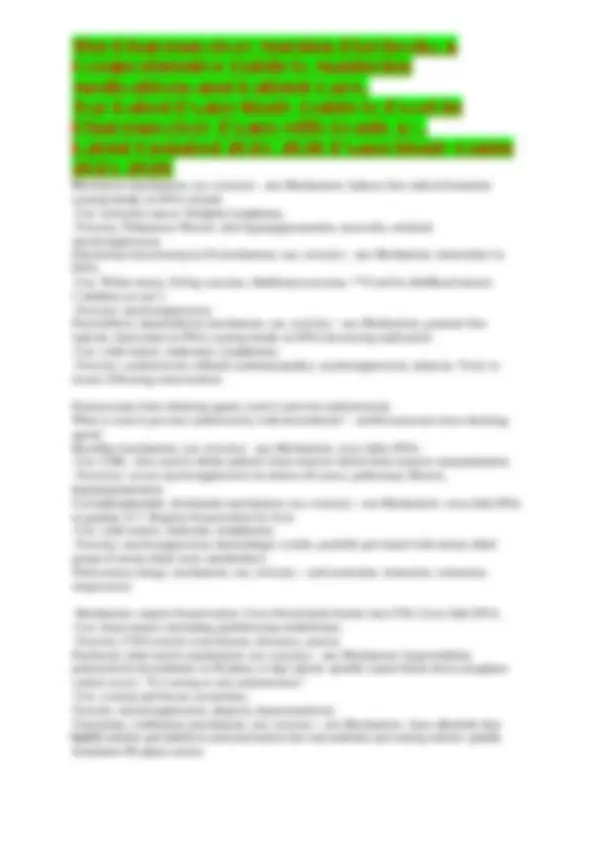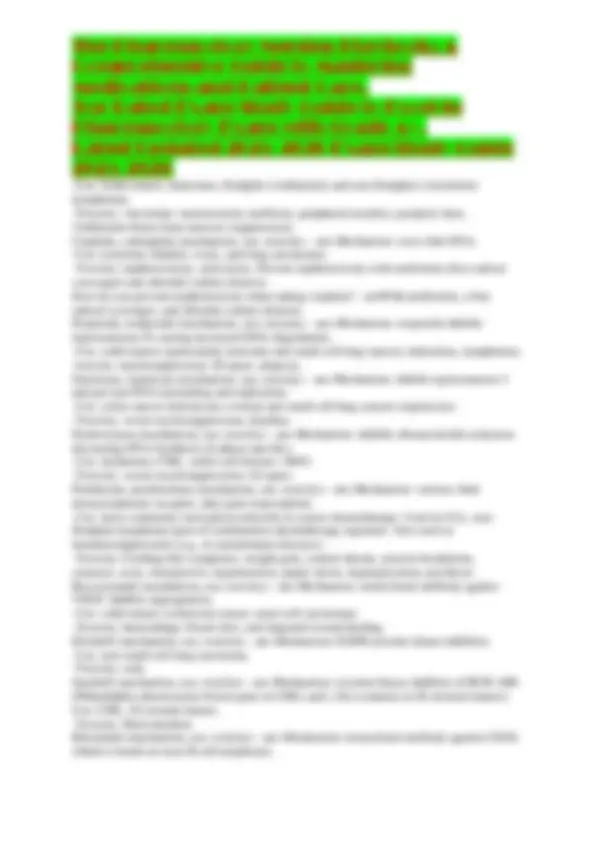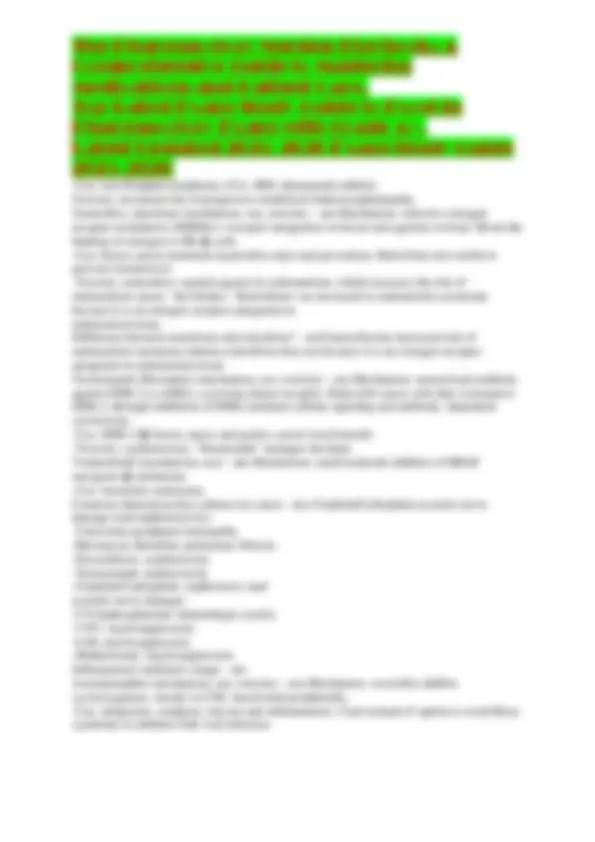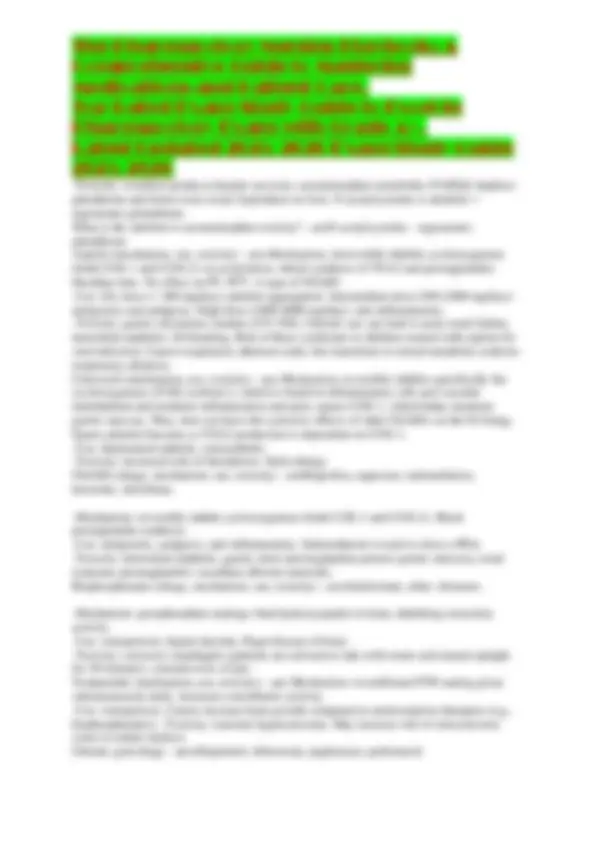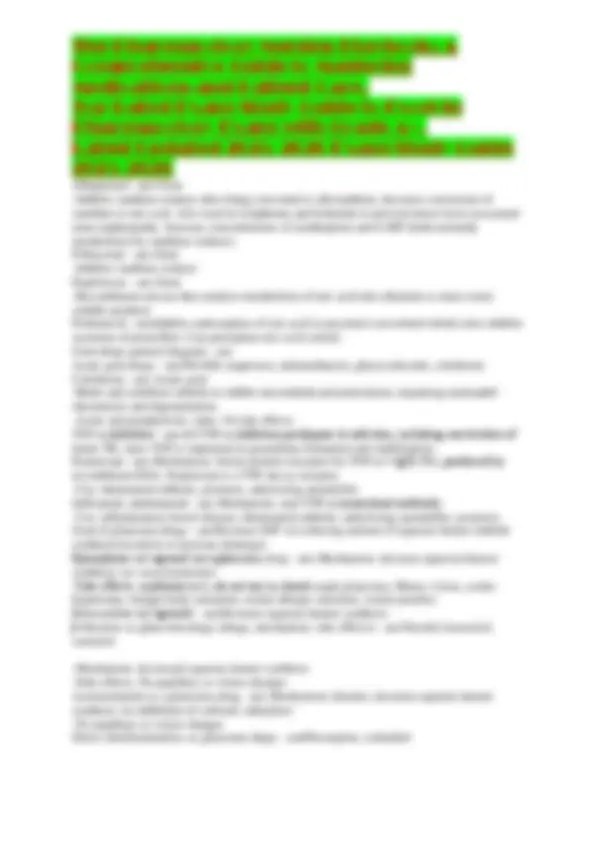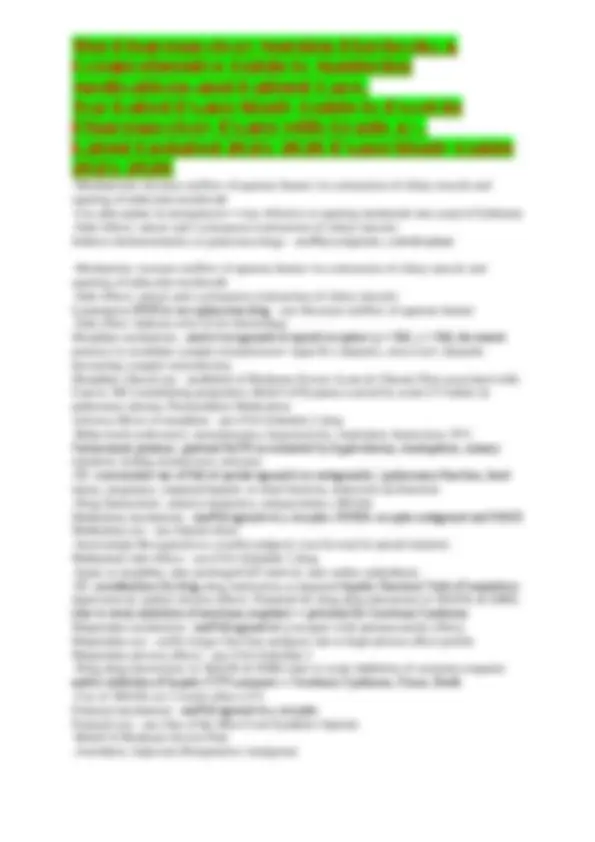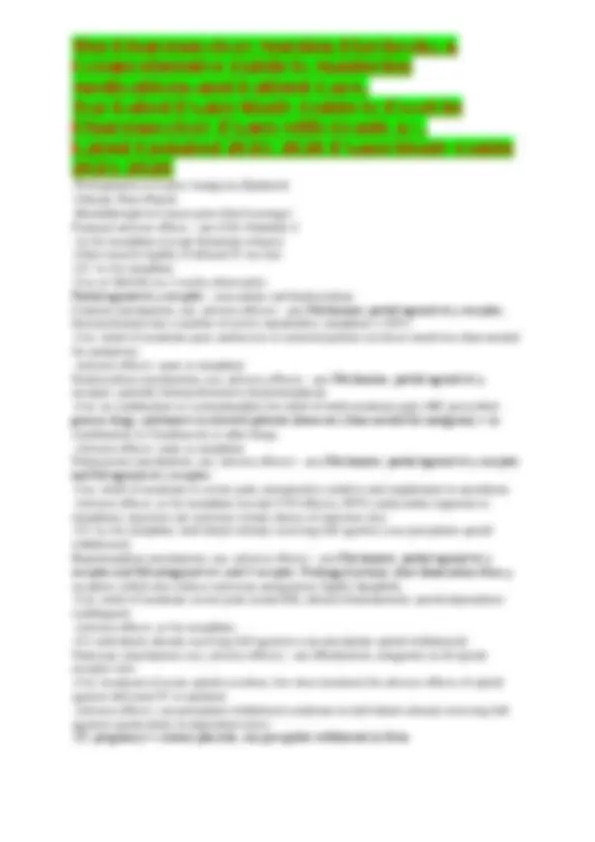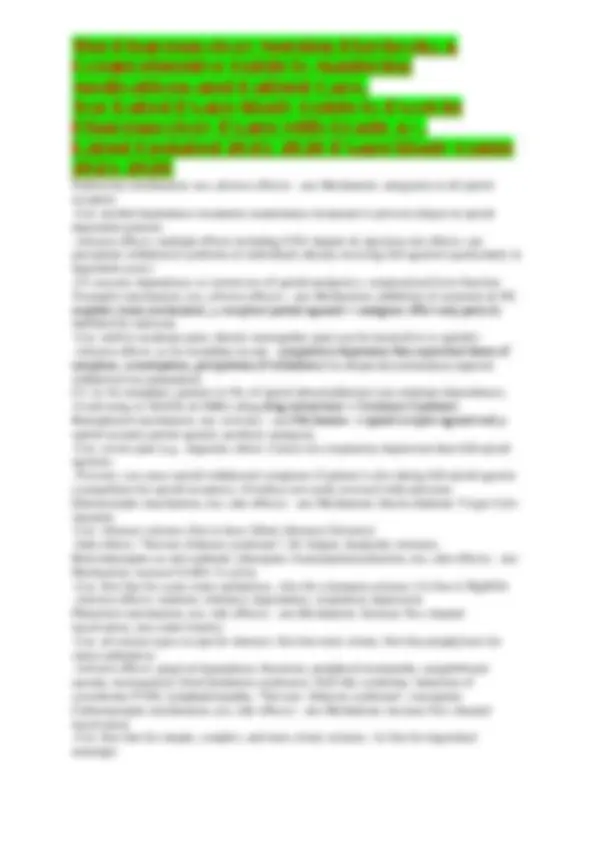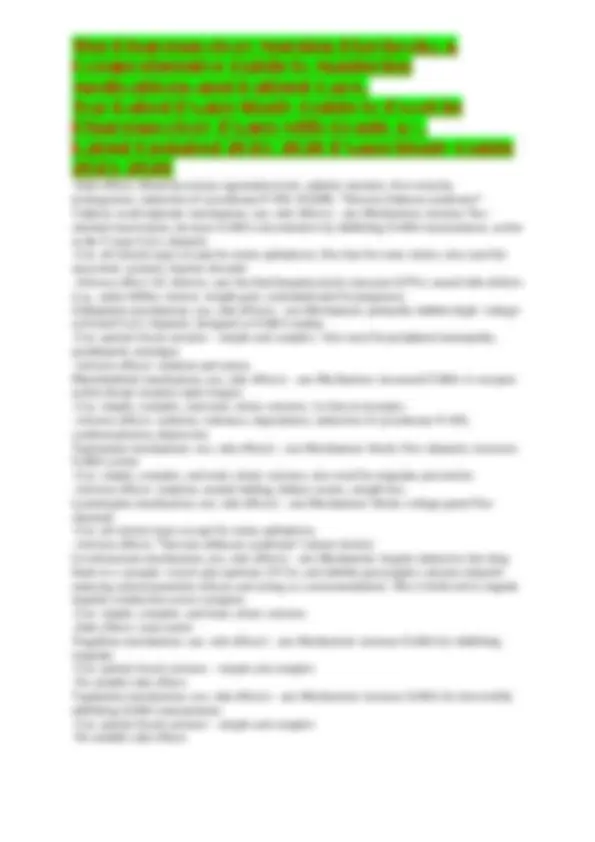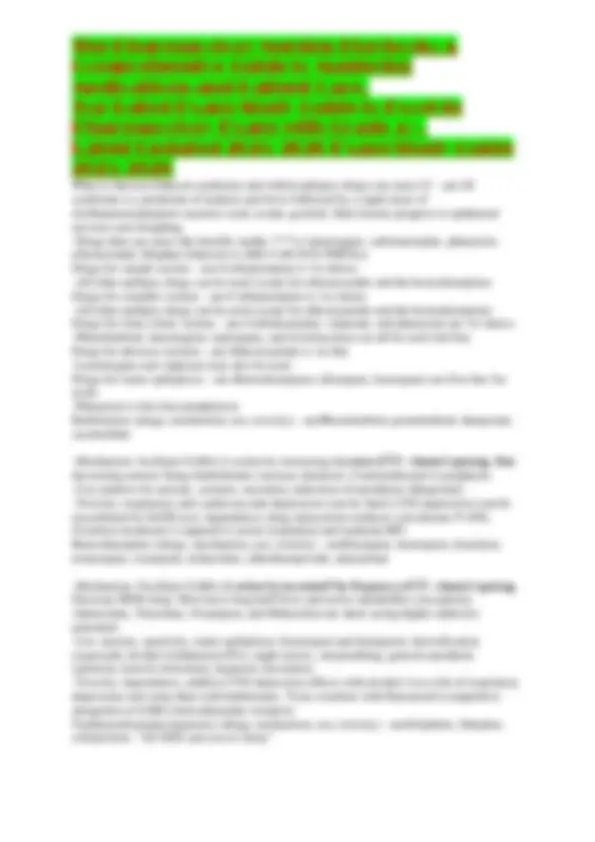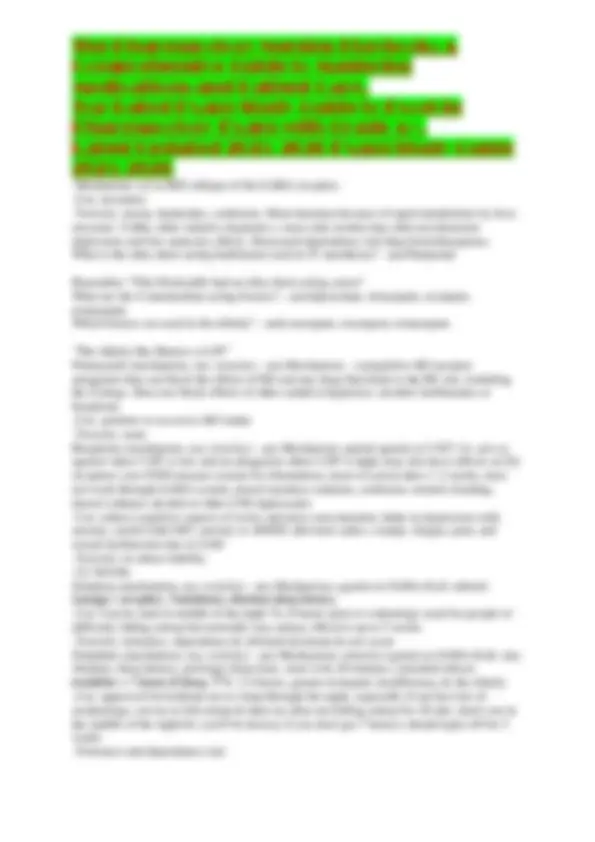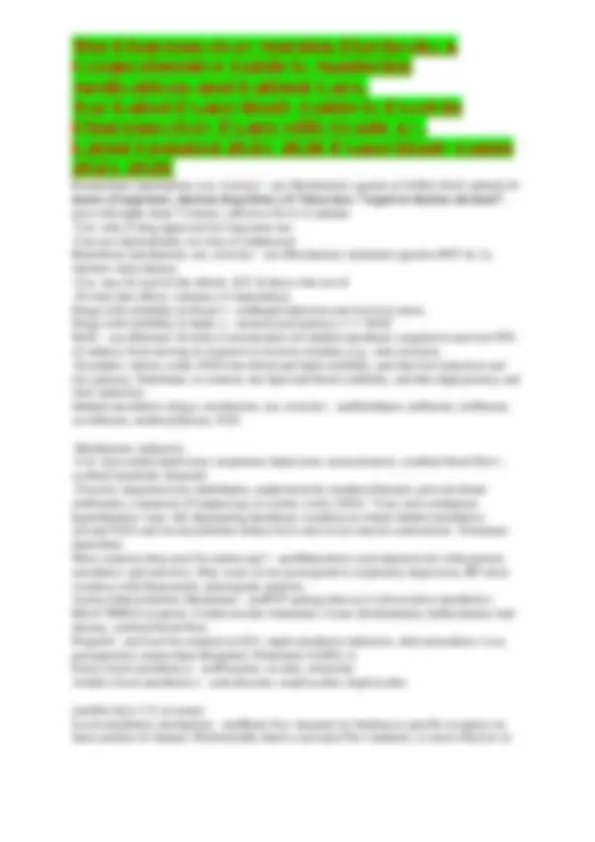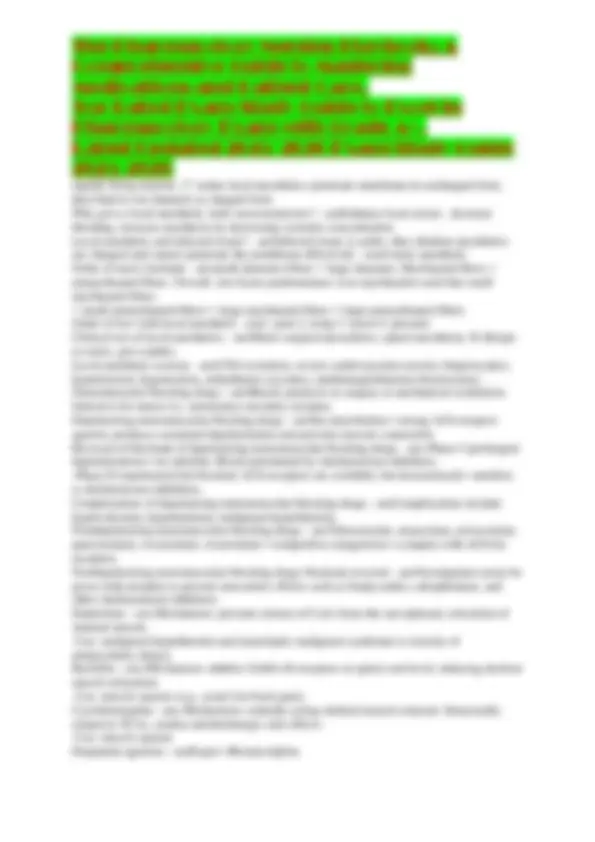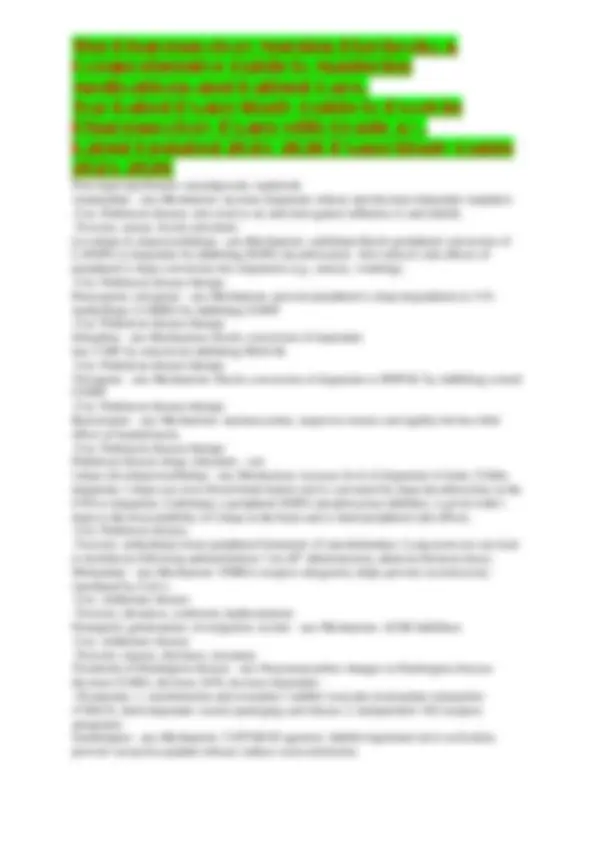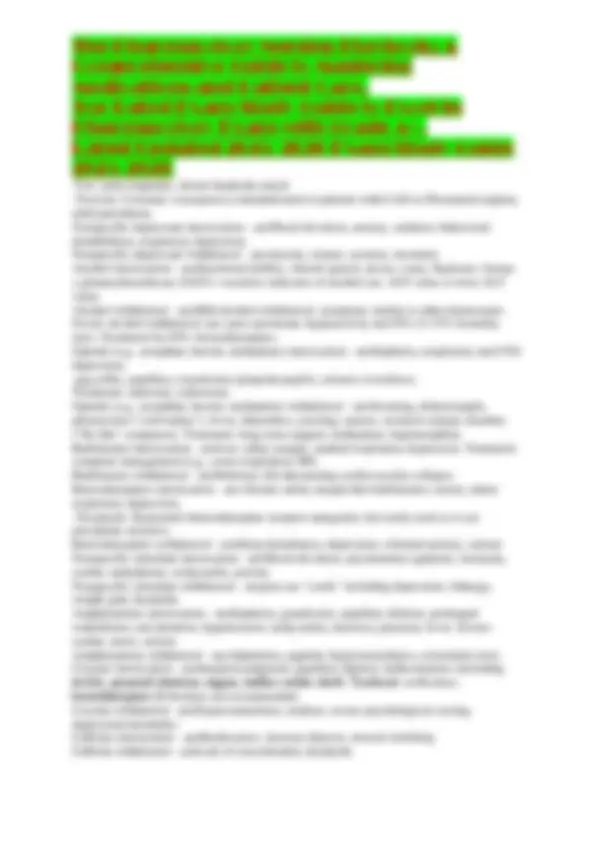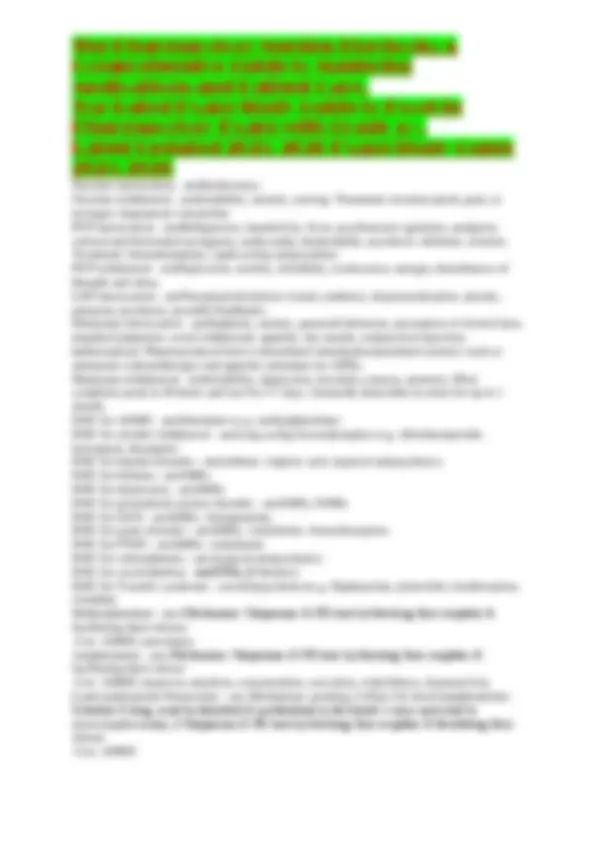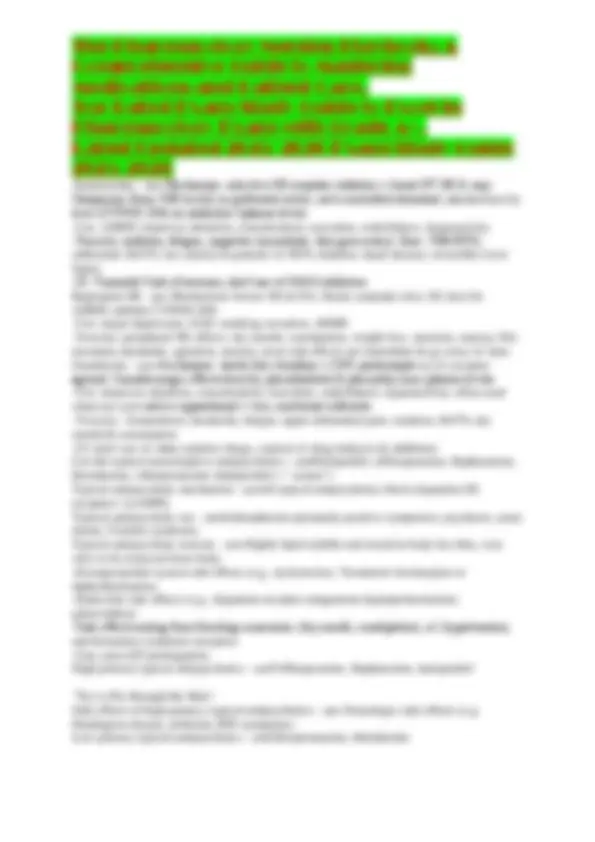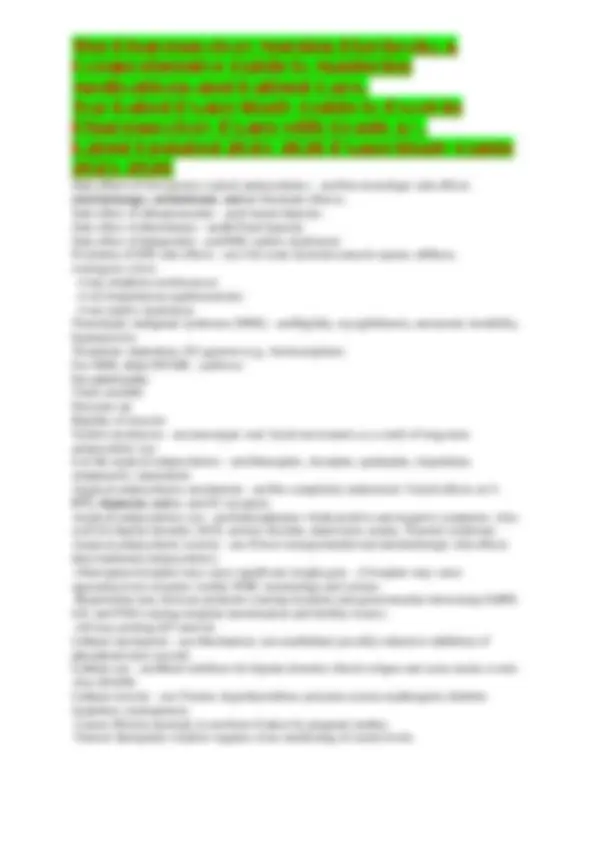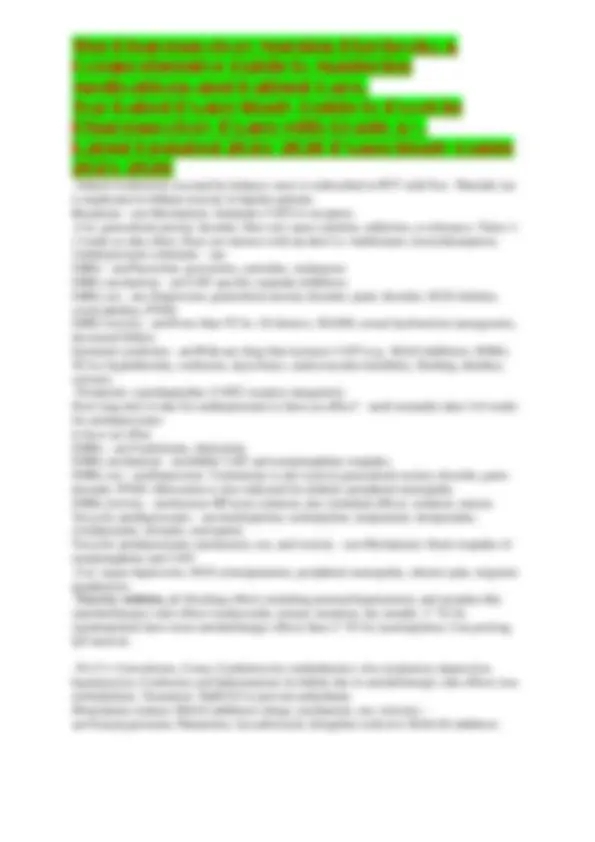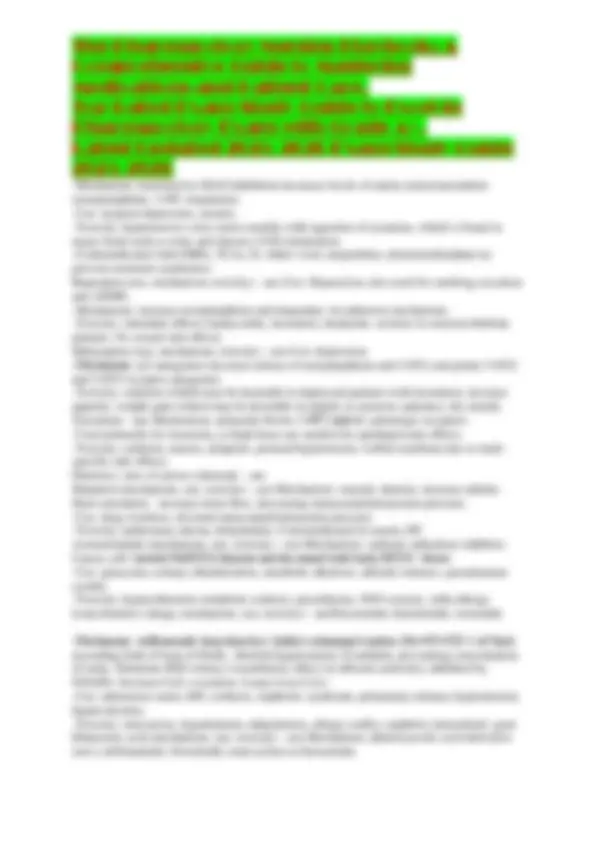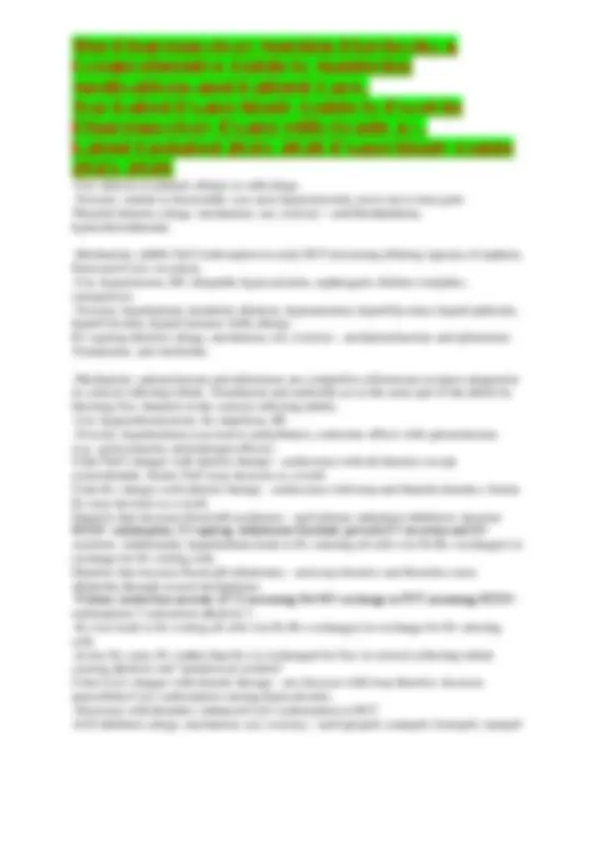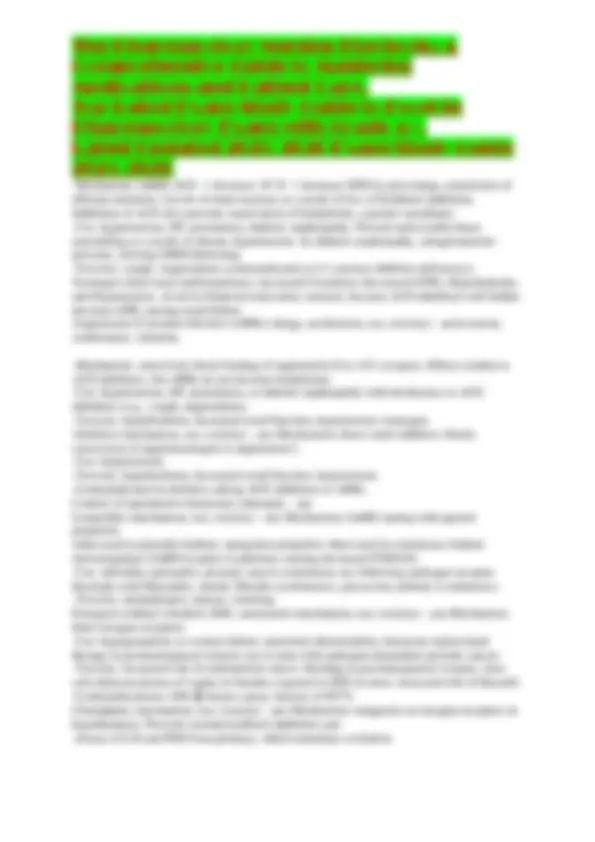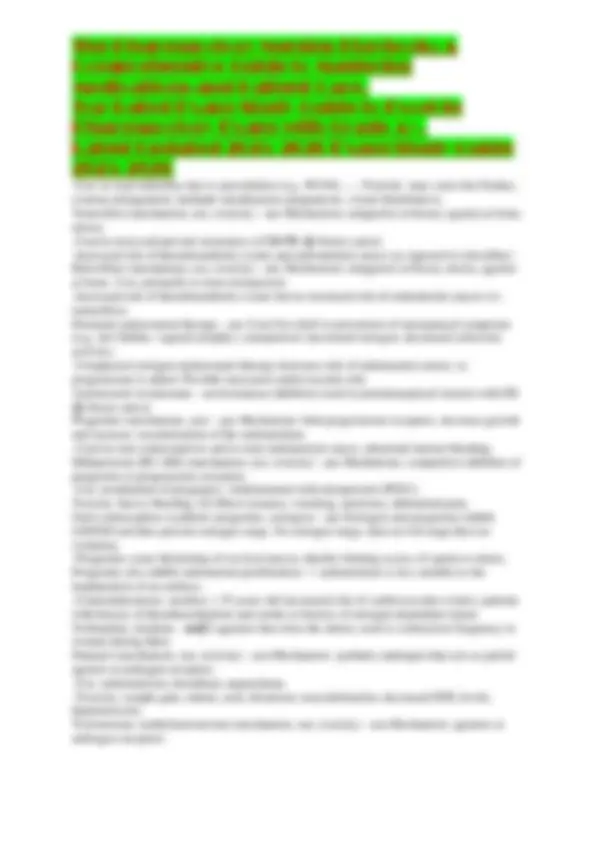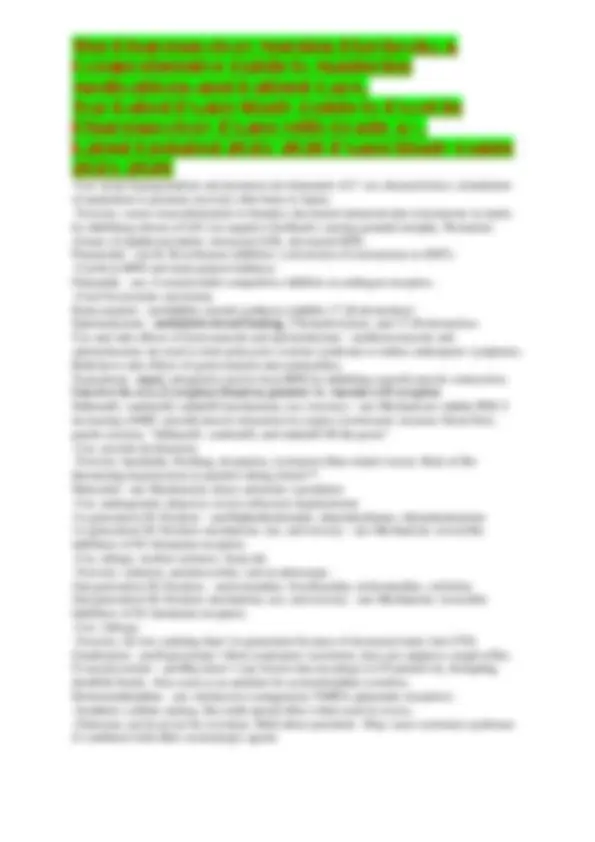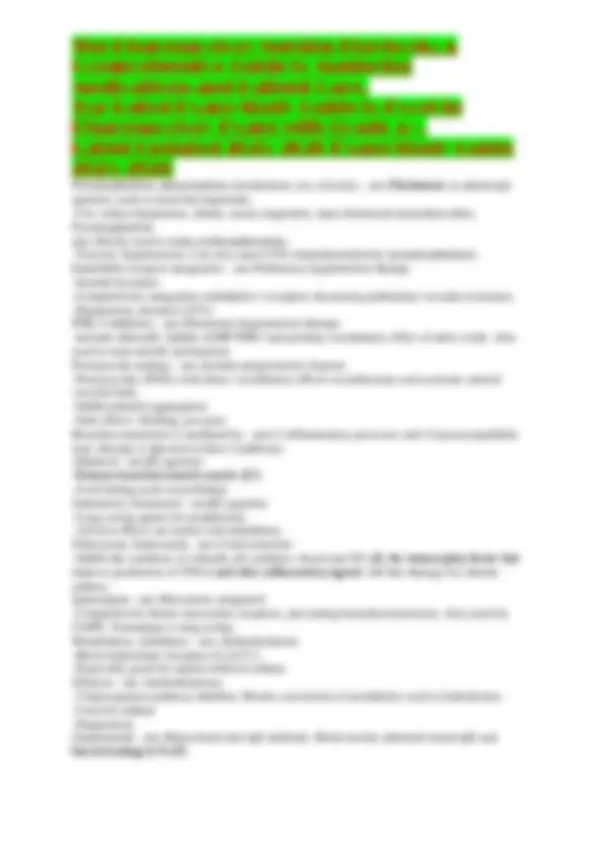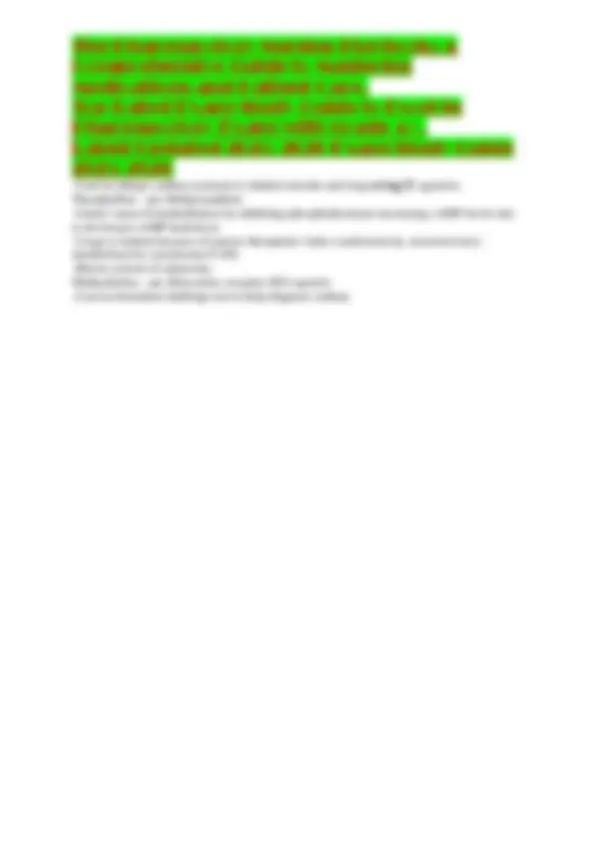Download The Pharmacology Nursing Playbook: A Comprehensive Guide to Mastering Medications and Pa and more Exams Nursing in PDF only on Docsity!
Comprehensive Guide to Mastering
Medications and Patient Care.
Top Rated Exam Study Guide to Excel in
Pharmacology Exam with Grade A+.
Latest Updated 2025/2026 Exam Study Guide
What are the major functions of the α1 receptor? - ansIncrease vascular smooth muscle contraction, increase pupillary dilator muscle contraction (mydriasis), increase intestinal and bladder sphincter muscle contraction What are the major functions of the α2 receptor? - ansDecrease sympathetic outflow, decrease insulin release, decrease lipolysis, increase platelet aggregation, decrease aqueous humor production What are the major functions of the β1 receptor? - ansIncrease heart rate, increase contractility, increase renin release, increase lipolysis What are the major functions of the β2 receptor? - ansVasodilation, bronchodilation, increase lipolysis, increase insulin release, decrease uterine tone (tocolysis), ciliary muscle relaxation, increase aqueous humor production What are the major functions of the M1 receptor? - ansCNS, enteric nervous system What are the major functions of the M2 receptor? - ansDecrease heart rate and contractility of atria What are the major functions of the M3 receptor? - ansIncrease exocrine gland secretions (e.g., lacrimal, salivary, gastric acid), increase gut peristalsis, increase bladder contraction, increase bronchoconstriction, pupillary sphincter muscle contraction (miosis), ciliary muscle contraction (accommodation) What are the major functions of the D1 receptor? - ansRelaxes renal vascular smooth muscle What are the major functions of the D2 receptor? - ansModulates transmitter release, especially in the brain What are the major functions of the H1 receptor? - ansIncrease nasal and bronchial mucus production, increase vascular permeability, contraction of bronchioles, pruritis, pain What are the major functions of the H2 receptor? - ansIncrease gastric acid secretion What are the major functions of the V1 receptor? - ansIncrease vascular smooth muscle contraction What are the major functions of the V2 receptor? - ansIncrease H2O permeability and reabsorption in collecting tubules of kidney (V2 is found in the "2" kidneys) What receptors are associate with Gq? - ansH1, α1, V1, M1, and M What receptors are associated with Gs? - ansH2, B1, B2, V2, D What receptors are associated with Gi? - ansM2, α2, D Bethanechol - ans-Direct cholinergic agonist
- Activates bowel and bladder smooth muscle
- Used in postoperative and neurogenic ileus
- Resistant to AChE Carbachol - ans-Direct cholinergic agonist
- Carbon copy of acetylcholine
- Constricts pupils and relieves intraocular pressure in glaucoma Methacholine - ans-Direct cholinergic agonist
- Stimulates muscarinic receptors in airways when inhaled
- Used as a challenge test for diagnosis of asthma Pilocarpine - ans-Direct cholinergic agonist
Comprehensive Guide to Mastering
Medications and Patient Care.
Top Rated Exam Study Guide to Excel in
Pharmacology Exam with Grade A+.
Latest Updated 2025/2026 Exam Study Guide
- Contracts ciliary muscle of eye (open angle glaucoma), contracts pupillary sphincter (closed angle glaucoma)
- Potent stimulator of sweat, tears and saliva
- AChE resistant Donepezil - ans-Anticholinesterse - increases ACh
- Alzheimer disease Galantamine - ans-Anticholinesterse - increases ACh
- Alzheimer disease Rivastigmine - ans-Anticholinesterse - increases ACh
- Alzheimer disease Edrophonium - ans-Anticholinesterse - increases ACh
- Historically used to diagnose myasthenia gravis (MG is now diagnosed by anti-AChR Ab test. Neostigmine - ans-Anticholinesterse - increases ACh
- Used in postoperative and neurogenic ileus and urinary retention, myasthenia gravis, and postoperative reversal of neuromuscular junction blockade Physostigmine - ans-Anticholinesterse - increases ACh
- Used in anticholinergic toxicity
- Crosses the blood-brain barrier (CNS) Pyridostigmine - ans-Anticholinesterse - increases ACh
- Increases muscle strength
- Used in myasthenia gravis (long acting)
- Does not penetrate CNS Atropine - ans-Muscarinic antagonist
- Used in bradycardia and for ophthalmic applications
- Also used as antidote for cholinesterase inhibitor poisoning
- Actions include increase pupil dilation, cycloplegia, decreased airway secretions, decreased acid secretions, decreased gut motility, decreased bladder urgency in cystitis
- Toxicity: increased body temp (due to decreased sweating), rapid pulse, dry mouth, dry and flushed skin, cycloplegia, constipation, disorientation;
- Can cause acute angle-closure glaucoma in elderly (due to mydriasis), urinary retention in men with prostatic hyperplasia, and hyperthermia in infants
- See also homatropine and tropicamide Benztropine - ans-Muscarinic antagonist
- Works in CNS
- Used in Parkinson disease and acute dystonia Glycopyrrolate - ans-Muscarinic antagonist
- Parental use: preoperative use to reduce airway secretions
- Oral use: drooling, peptic ulcer Hyoscyamine - ans-Muscarinic antagonist
- Antispasmodics for IBS Dicyclomide - ans-Muscarinic antagonist
Comprehensive Guide to Mastering
Medications and Patient Care.
Top Rated Exam Study Guide to Excel in
Pharmacology Exam with Grade A+.
Latest Updated 2025/2026 Exam Study Guide
- Uses: heart failure (HF) (inotropic > chronotropic), cardiac stress testing. Dopamine - ans-D1 = D2 > β > α direct agonist
- Uses: unstable bradycardia, HF, shock; inotropic and chronotropic α effects predominate at high doses. Epinephrine - ans-β > α direct agonist
- Uses: anaphylaxis, asthma, open-angle glaucoma; α effects predominate at high doses. Significantly stronger effect at β2-receptor than norepinephrine. Isoprterenol - ans-β1 = β2 direct agonist
- Uses: electrophysiologic evaluation of tachyarrhythmias. Can worsen ischemia Norepinephrine - ans-α1 > α2 > β1 direct agonist
- Hypotension (butrenal perfusion). Significantly weaker effect at β2-receptor than epinephrine. Phenylephrine - ans-α1 > α2 direct agonist
- Uses: hypotension (vasoconstrictor), ocular procedures (mydriatic), rhinitis (decongestant) Amphetamine - ans-Indirect general sympathetic agonist
- reuptake inhibitor; also releases stored catecholamines
- Narcolepsy, obesity, ADHD. Cocaine - ans-Indirect general sympathetic agonist
- Reuptake inhibitor
- Causes vasoconstriction and local anesthesia.
- Never give β-blockers if cocaine intoxication is suspected (can lead to unopposed α1 activation and extreme hypertension). Ephedrine - ans-Indirect general sympathetic agonist
- Releases stored catecholamines
- Nasal decongestion, urinary incontinence, hypotension. Norepinephrine vs. isoproterenol - ans-Norepinephrine increases systolic and diastolic pressures as a result of α1-mediated vasoconstriction causing increased in mean arterial pressure and reflex bradycardia. - However, isoproterenol (no longer commonly used) has little α effect but causes β2-mediated vasodilation, resulting in decreased mean arterial pressure and increased heart rate through β1 and reflex activity. Clonidine - ans-α2-agonist
- Uses: hypertensive urgency (limited situations); does not decrease renal blood flow; ADHD, Tourette syndrome
- Toxicity: CNS depression, bradycardia, hypotension, respiratory depression, miosis α-methyldopa - ans-α2-agonist
- Used for hypertension in pregnancy
- Toxicity: Direct Coombs ⊕ hemolysis, SLE-like syndrome Phenoxybenzamine - ans-Nonselective α-blocker
- Irreversible
- Used preoperatively for pheochromocytoma to prevent catecholamine (hypertensive) crisis
- Toxicity: orthostatic hypotension, reflex tachycardia
Comprehensive Guide to Mastering
Medications and Patient Care.
Top Rated Exam Study Guide to Excel in
Pharmacology Exam with Grade A+.
Latest Updated 2025/2026 Exam Study Guide
Phentolamine - ans-Nonselective α-blocker
- Give to patients on MAO inhibitors who eat tyramine containing foods
- Toxicity: orthostatic hypotension, reflex tachycardia Prazosin - ans-Selective α1-blocker
- Uses: urinary symptoms of BPH; PSTD
- Hypertension
- Toxicity: 1st-dose orthostatic hypotension, dizziness, headache Terazosin - ans-Selective α1-blocker
- Uses: urinary symptoms of BPH;
- Hypertension
- Toxicity: 1st-dose orthostatic hypotension, dizziness, headache Doxazosin - ans-Selective α1-blocker
- Uses: urinary symptoms of BPH;
- Hypertension
- Toxicity: 1st-dose orthostatic hypotension, dizziness, headache Tamsulosin - ans-Selective α1-blocker
- Uses: urinary symptoms of BPH;
- Toxicity: 1st-dose orthostatic hypotension, dizziness, headache Mirtazapine - ans-Selective α2-blocker
- Used in depression
- Toxicity: sedation, increased serum cholesterol, increased appetite α-blockade of epinephrine vs. phenylephrine - ansShown in the picture are the effects of an α- blocker (e.g., phentolamine) on blood pressure responses to epinephrine and phenylephrine. The epinephrine response exhibits reversal of the mean blood pressure change, from a net increase (the α response) to a net decrease (the β2 response). The response to phenylephrine is suppressed but not reversed because phenylephrine is a "pure" α-agonist without β action. Effects of β-blockers - ans-Angina pectoris—decrease heart rate and contractility, resulting in decrease O2 consumption
- MI—β-blockers (metoprolol, carvedilol, and bisoprolol) mortality
- SVT (metoprolol, esmolol)—decrease AV conduction velocity (class II antiarrhythmic)
- Hypertension—decrease cardiac output, decrease renin secretion (due to β1-receptor blockade on JGA cells)
- HF—decrease mortality in chronic HF
- Glaucoma (timolol)—decrease secretion of aqueous humor Nonselective β-blockers - ans-Nadolol, pindolol (partial agonist), propranolol, timolol
- Mostly go from N to Z β1-selective antagonist - ans-acebutolol (partial agonist), atenolol, betaxolol, esmolol, metoprolol
- Mostly go from A to M Nonselective α- and β-antagonists - ans-Carvedilol, labetalol Nebevolol - ans-Combines cardiac-selective β1-adrenergic blockade with stimulation of β3- receptors, which activate nitric oxide synthase in the vasculature
Comprehensive Guide to Mastering
Medications and Patient Care.
Top Rated Exam Study Guide to Excel in
Pharmacology Exam with Grade A+.
Latest Updated 2025/2026 Exam Study Guide
Drugs that cause diarrhea - ansMetformin, Erythromycin, Colchicine, Orlistat, Acarbose Drugs that cause focal to massive hepatic necrosis - ansHalothane, Amanita phalloides (death cap mushroom), Valproic acid, Acetaminophen Drugs that cause hepatitis - ansRifampin, isoniazid, pyrazinamide, statins, fibrates Drugs that cause pancreatitis - ansDidanosine, Corticosteroids, Alcohol, Valproicacid, Azathioprine, Diuretics (furosemide, HCTZ) Drugs that cause pseudomembranous colitis - ansClindamycin, ampicillin, cephalosporins Drugs that cause agranulocytosis - ansGanciclovir, Clozapine, Carbamazepine, Colchicine, Methimazole, Propylthiouracil Drugs that cause aplastic anemia - ansCarbamazepine, Methimazole, NSAIDs, Benzene, Chloramphenicol, Propylthiouracil Drugs that cause direct Coombs- positive hemolytic anemia - ansMethyldopa, penicillin Drugs that cause gray baby syndrome - ansChloramphenicol Drugs that cause hemolysis in G6PD deficiency - ansIsoniazid, Sulfonamides, Dapsone, Primaquine, Aspirin, Ibuprofen, Nitrofurantoin Drugs that cause thrombocytopenia - ansHeparin Drugs that cause thrombotic complications - ansOCPs, hormone replacement therapy Drugs that cause gingival hyperplasia - ansPhenytoin, Ca2+ channel blockers, cyclosporine Drugs that cause gout - ansPyrazinamide, Thiazides, Furosemide, Niacin, Cyclosporine Drugs that cause myopathy - ansFibrates, niacin, colchicine, hydroxychloroquine, interferon- α, penicillamine, statins, glucocorticoids Drugs that cause osteoporosis - ansCorticosteroids, heparin Drugs that cause photosensitivity - ansSulfonamides, Amiodarone, Tetracyclines, 5 - FU Drugs that cause Stevens-Johnson syndrome - ansAnti-epileptic drugs (especially lamotrigine), allopurinol, sulfa drugs, penicillin Drugs that cause SLE-like syndrome - ansSulfa drugs, Hydralazine, Isoniazid, Procainamide, Phenytoin, Etanercept Drugs that cause teeth discoloration - ansTetracyclines (TETra=bad TEeTh) Drugs that cause tendonitis, tendon rupture, and cartilage damage - ansFluoroquinolones Drugs that cause cinchonism (symptoms are tinnitus and slight deafness, photophobia and other visual disturbances, mental dullness, depression, confusion, headache, and nausea) - ansQuinidine, quinine Drugs that cause Parkinson-like syndrome - ansAntipsychotics, Reserpine, Metoclopramide Drugs that cause seizures - ansIsoniazid (vitamin B6 deficiency), Bupropion, Imipenem/cilastatin, Enflurane Drugs that cause tardive dyskinesia - ansAntipsychotics, metoclopramide Drugs that cause diabetes insipidus - ansLithium, demeclocycline Drugs that cause fanconi syndrome - ansExpired tetracycline
Comprehensive Guide to Mastering
Medications and Patient Care.
Top Rated Exam Study Guide to Excel in
Pharmacology Exam with Grade A+.
Latest Updated 2025/2026 Exam Study Guide
Drugs that cause hemorrhagic cystitis - ansCyclophosphamide, ifosfamide Drugs that cause interstitial nephritis - ansMethicillin, NSAIDs, furosemide Drugs that cause SIADH - ansCarbamazepine, Cyclophosphamide, SSRIs Drugs that cause dry cough - ansACE inhibitors Drugs that cause pulmonary fibrosis - ansBleomycin, amiodarone, methotrexate, busulfan Drugs that cause antimuscarinic reaction - ansAtropine, TCAs, H1-blockers, antipsychotics Drugs that cause disulfiram-like reaction - ansMetronidazole, certain cephalosporins, griseofulvin, procarbazine, 1st-generation sulfonylureas Drugs that cause nephrotoxicity/ototoxicity - ansAminoglycosides, vancomycin, loop diuretics, cisplatin. Cisplatin toxicity may respond to amifostine. Cytochrome P-450 inducers - ansChronic alcohol use, St. John's wort, Phenytoin Phenobarbital, Nevirapine, Rifampin, Griseofulvin, Carbamazepine Cytochrome P-450 substrates - ansAnti-epileptics, Theophylline, Warfarin OCPs Cytochrome P-450 inhibitors - ansAcute alcohol abuse, Ritonavir, Amiodarone, Cimetidine, Ketoconazole, Sulfonamides, Isoniazid (INH), Grapefruit juice, Quinidine, Macrolides, (except azithromycin) Sulfa drugs - ansProbenecid, Furosemide, Acetazolamide, Celecoxib, Thiazides, Sulfonamide antibiotics, Sulfasalazine, Sulfonylureas. Patients with sulfa allergies may develop fever, urinary tract infection, Stevens- Johnson syndrome, hemolytic anemia, thrombocytopenia, agranulocytosis, and urticaria (hives). Symptoms range from mild to life threatening.
- azole - ansErgosterol synthesis inhibitor
- bendazole - ansAntiparasitic/antihelmintic
- cillin - ansPeptidoglycan synthesis inhibitor
- cycline - ansProtein synthesis inhibitor
- ivir - ansNeuraminidase inhibitor
- navir - ansProtease inhibitor
- ovir - ansDNA polymerase inhibitor
- thromycin - ansMacrolide antibiotic
- ane - ansInhalational general anesthetic
- azine - ansTypical antipsychotic
- barbital - ansBarbiturate
- caine - ansLocal anesthetic
- etine - ansSSRI
- ipramine, - triptyline - ansTCA
- triptan - ans5-HT1B/1D agonists
- zepam, - zolam - ansBenzodiazepine
- chol - ansCholinergic agonist
- curium, - curonium - ansNondepolarizing paralytic
- olol - ansβ-blocker
Comprehensive Guide to Mastering
Medications and Patient Care.
Top Rated Exam Study Guide to Excel in
Pharmacology Exam with Grade A+.
Latest Updated 2025/2026 Exam Study Guide
- Same mechanism as penicillin (inhibits peptidoglycan cross-linking); extended spectrum
- Use: Pseudomonas spp. and gram-negative rods; susceptible to penicillinase; use with β- lactamase inhibitors.
- Toxicity: hypersensitivity reactions β-lactamase inhibitors - ans-Clavulanic Acid, Sulbactam, Tazobactam
- Often added to penicillin antibiotics to protect the antibiotic from destruction by β-lactamase (penicillinase). Mechanism of action of cephalosporins - ans-β-lactam drugs that inhibit cell wall synthesis but are less susceptible to penicillinases. Bactericidal.
- Organisms typically not covered by cephalosporins are LAME: Listeria, Atypicals (Chlamydia, Mycoplasma), MRSA, and Enterococci. Exception: ceftaroline covers MRSA. 1st generation cephalosporins - ansCefazolin, cephalexin Use: Gram- positive cocci, Proteus mirabilis, E. coli, Klebsiella pneumoniae. Cefazolin used prior to surgery to prevent S. aureus wound infections 2nd generation cephalosporins - ans-Cefoxitin, cefaclor, cefuroxime
- Use: gram-positive cocci, Haemophilus influenzae, Enterobacter aerogenes, Neisseria spp., Proteus mirabilis, E. coli, Klebsiella pneumoniae, Serratia marcescens. 3rd generation cephalosporins - ans-Ceftriaxone, cefotaxime, ceftazidime)
- Use: serious gram-negative infections resistant to other β-lactams. Ceftriaxone—meningitis, gonorrhea, disseminated lyme disease; ceftazidime—Pseudomonas 4th generation cephalosporins - ans-Cefepime
- Use: gram-negative organisms, with activity against Pseudomonas and gram-positive organisms. 5th generation cephalosporins - ans-Ceftaroline
- Use: broad gram-positive and gram-negative organism coverage, including MRSA; does not cover Pseudomonas. Cephalosporin toxicity - ans-Hypersensitivity reactions, autoimmune hemolytic anemia, disulfiram-like reaction, vitamin K deficiency.
- Exhibit cross-reactivity with penicillins.
- Increased nephrotoxicity of aminoglycosides. Mechanism of resistance of cephalosporins - ansStructural change in penicillin-binding proteins (transpeptidases) Carbapenems - ans-Imipenem, meropenem, ertapenem, doripenem
- Imipenem is a broad-spectrum, β-lactamase- resistant carbapenem. Always administered with cilastatin (inhibitor of renal dehydropeptidase I) to decrease inactivation of drug in renal tubules
- Use: gram-positive cocci, gram-negative rods, and anaerobes. Wide spectrum, but significant side effects limit use to life-threatening infections or after other drugs have failed. Meropenem has arisk of seizures and is stable to dehydropeptidase I
- Toxicity: GI distress, skin rash, and CNS toxicity (seizures) at high plasma levels Aztreonam - ans-Monobactam
Comprehensive Guide to Mastering
Medications and Patient Care.
Top Rated Exam Study Guide to Excel in
Pharmacology Exam with Grade A+.
Latest Updated 2025/2026 Exam Study Guide
- Less susceptible to β-lactamases. Prevents peptidoglycan cross-linking by binding to penicillin- binding protein 3.
- Synergistic with aminoglycosides. No cross-allergenicity with penicillins.
- Gram-negative rods only—no activity against gram-positives or anaerobes. For penicillin- allergic patients and those with renal insufficiency who cannot tolerate aminoglycosides.
- Usually nontoxic; occasional GI upset. Vancomycin - ans-Inhibits cell wall peptidoglycan formation by binding D-ala D-ala portion of cell wall precursors. Bactericidal. Not susceptible to β-lactamases.
- Gram-positive bugs only—serious, multidrug-resistant organisms, including MRSA, S. epidermidis, sensitive Enteroccocus species, and Clostridium difficile (oral dose for pseudomembranous colitis).
- Well tolerated in general—but NOT trouble free. Nephrotoxicity, Ototoxicity, Thrombophlebitis, diffuse flushing—red man syndrome (can largely prevent by pretreatment with antihistamines and slow infusion rate).
- Resistance occurs in bacteria via amino acid modification of D-ala D-ala to D-ala D-lac. "Pay back 2 D-alas (dollars) for vandalizing (vancomycin)." Aminoglycosides - ans-Gentamicin, neomycin, amikacin, tobramycin, streptomycin
- Bactericidal; irreversible inhibition of initiation complex through binding of the 30S subunit. Can cause misreading of mRNA. Also block translocation. Require O2 for uptake; therefore ineffective against anaerobes.
- Severe gram-negative rod infections. Synergistic with β-lactam antibiotics.
- Neomycin for bowel surgery.
- Toxicity: Nephrotoxicity, Neuromuscular blockade, Ototoxicity (especially when used with loop diuretics). Teratogen.
- Resistance: Bacterial transferase enzymes inactivate the drug by acetylation, phosphorylation, or adenylation. Tetracyclines - ans-Tetracycline, doxycycline, minocycline
- Bacteriostatic; bind to 30S and prevent attachment of aminoacyl-tRNA; limited CNS penetration. Doxycycline is fecally eliminated and can be used in patients with renal failure. Do not take tetracyclines with milk (Ca2+), antacids (Ca2+ or Mg2+), or iron-containing preparations because divalent cations inhibit drugs' absorption in the gut.
- Clinical use: Borrelia burgdorferi, M. pneumoniae. Drugs' ability to accumulate intracellularly makes them very effective against Rickettsia and Chlamydia. Also used to treat acne.
- Toxicity: GI distress, discoloration of teeth and inhibition of bone growth in children, photosensitivity. Contraindicated in pregnancy.
- Resistance: decrease uptake or increased efflux out of bacterial cells by plasmid-encoded transport pumps. Chloramphenicol - ans-Blocks peptidyltransferase at 50S ribosomal subunit.
- Bacteriostatic.
Comprehensive Guide to Mastering
Medications and Patient Care.
Top Rated Exam Study Guide to Excel in
Pharmacology Exam with Grade A+.
Latest Updated 2025/2026 Exam Study Guide
(Dapsone, used to treat lepromatous leprosy, is a closely related drug that also inhibits folate synthesis.)
- Gram-positives, gram-negatives, Nocardia, Chlamydia. Triple sulfas or SMX for simple UTI.
- Toxicity: Hypersensitivity reactions, hemolysis if G6PD deficient, nephrotoxicity (tubulointerstitial nephritis), photosensitivity, kernicterus in infants, displace other drugs from albumin (e.g., warfarin).
- Resistance: Altered enzyme (bacterial dihydropteroate synthase), decreased uptake, or increased PABA synthesis. Fluoroquinolones - ans-Ciprofloxacin, norfloxacin, levofloxacin, ofloxacin, moxifloxacin, gemifloxacin, enoxacin.
- Inhibit prokaryotic enzymes topoisomerase II (DNA gyrase) and topoisomerase IV. Bactericidal. Must not be taken with antacids.
- Gram-negative rods of urinary and GI tracts (including Pseudomonas), Neisseria, some gram-positive organisms. Toxicity: GI upset, superinfections, skin rashes, headache, dizziness. Less commonly, can cause leg cramps and myalgias.
- Contraindicated in pregnant women, nursing mothers, and children < 18 years old due to possible damage to cartilage. Some may prolong QT interval. May cause tendonitis or tendon rupture in people > 60 years old and in patients taking prednisone.
- Resistance: chromosome-encoded mutation in DNA gyrase, plasmid-mediated resistance, efflux pumps. Daptomycin - ans-Lipopeptide that disrupts cell membrane of gram-positive cocci.
- S. aureus skin infections (especially MRSA), bacteremia, endocarditis, VRE. Not used for pneumonia (avidly binds to and is inactivated by surfactant)
- Toxicity: myopathy, rhabdomyolysis. Metronidazole - ans-Forms toxic free radical metabolites in the bacterial cell that damage DNA. Bactericidal, antiprotozoal.
- Treats Giardia, Entamoeba, Trichomonas, Gardnerella vaginalis, Anaerobes (Bacteroides, C. difficile). Used with a proton pump inhibitor and clarithromycin for "triple therapy" against H. Pylori.
- Treats anaerobic infection below the diaphragm vs. clindamycin (anaerobic infections above diaphragm). Toxicity: Disulfiram-like reaction (severe flushing, tachycardia, hypotension) with alcohol; headache, metallic taste. What is the prophylaxis for M. tuberculosis? - ansIsoniazid What is the treatment for M. tuberculosis? - ansRifampin, isoniazid, pyrazinamide, ethambutol (RIPE) What is the prophylaxis for M. avium-intracellulare? - ansAzithromycin, rifabutin What is the treatment for M. avium-intracellulare? - ansMore drug resistant than M. tuberculosis. Azithromycin or clarithromycin + ethambutol. Can add rifabutin or ciprofloxacin.
Comprehensive Guide to Mastering
Medications and Patient Care.
Top Rated Exam Study Guide to Excel in
Pharmacology Exam with Grade A+.
Latest Updated 2025/2026 Exam Study Guide
What is the prophylaxis for M. leprae? - ansNone What is the treatment for M. leprae? - ansLong-term treatment with dapsone and rifampin for tuberculoid form. Add clofazimine for lepromatous form. Rifamycins - ans-Rifampin, rifabutin
- Inhibit DNA-dependent RNA polymerase
- Mycobacterium tuberculosis; delay resistance to dapsone when used for leprosy. Used for meningococcal prophylaxis and chemoprophylaxis in contacts of children with Haemophilus influenzae type B.
- Toxicity: minor hepatotoxicity and drug interactions (cytochrome P-450); orange body fluids (nonhazardous side effect). Rifabutin favored over rifampin in patients with HIV infection due to less cytochrome P-450 stimulation.
- Resistance: mutations reduce drug binding to RNA polymerase. Monotherapy rapidly leads to resistance. Isoniazid - ans-Decrease synthesis of mycolic acids. Bacterial catalase- peroxidase (encoded by KatG) needed to convert INH to active metabolite.
- Use in Mycobacterium tuberculosis. The only agent used as solo prophylaxis against TB.
- Toxicity: Neurotoxicity, hepatotoxicity. Pyridoxine (vitamin B6) can prevent neurotoxicity.
- Resistance: mutations leading to underexpression of KatG. Pyrazinamide - ans-Mechanism uncertain. Pyrazinamide is a prodrug that is converted to the active compound pyrazinoic acid.
- Use: Mycobacterium tuberculosis.
- Toxicity: Hyperuricemia, hepatotoxicity. Ethambutol - ans-Reduces carbohydrate polymerization of mycobacterium cell wall by blocking arabinosyltransferase.
- Use: Mycobacterium tuberculosis.
- Toxicity: optic neuropathy (red-green color blindness). High risk for endocarditis and undergoing surgical or dental procedures - ansAmoxicillin Exposure to gonorrhea - ansCeftriaxone History of recurrent UTIs - ansTMP-SMX Exposure to meningococcal infection - ansCeftriaxone, ciproflaxacin, or rifampin Pregnant woman carrying group B strep - ansPenicillin G Prevention of gonococcal conjunctivitis in newborn - ansErythromycin ointment Prevention of postsurgical infection due to S. aureus - ansCefazolin Prophylaxis of strep pharyngitis in child with prior rheumatic fever - ansBenzanthine penicillin G or or penicillin V Exposure to syphili - ansBenzanthine penicillin G Prophylaxis in HIV patients - ans Treatment of MRSA - ansVancomycin, daptomycin, linezolid, tigecycline, ceftaroline Treatment of Vancomycin-resistant enterococci (VRE) - ansLinezolid and streptogramins (quinupristin, dalfopristin).
Comprehensive Guide to Mastering
Medications and Patient Care.
Top Rated Exam Study Guide to Excel in
Pharmacology Exam with Grade A+.
Latest Updated 2025/2026 Exam Study Guide
Oral treatment of superficial infections; inhibits growth of dermatophytes (tinea, ringworm). Teratogenic, carcinogenic, confusion, headaches, cytochrome P-450 and warfarin metabolism. Toxoplasmosis therapy - ansPyrimethamine Trypanosoma brucei therapy - ansSuramin and melarsoprol T. cruzi therapy - ansNifurtimox Leishmaniasis therapy - ansSodium stibogluconate Anti-mite/louse therapy - ans-Permethrin (blocks Na+ channels neurotoxicity), malathion (acetylcholinesterase inhibitor), lindane (blocks GABA channels neurotoxicity).
- Used to treat scabies (Sarcoptes scabiei) and lice (Pediculus and Pthirus). Chloroquine MoA - ansBlocks detoxification of heme into hemozoin. Heme accumulates and is toxic to plasmodia Chloroquine clinical use - ansTreatment of plasmodial species other than P. falciparum (frequency of resistance in P. falciparum is too high). Resistance due to membrane pump that intracellular concentration of drug. Treat P. falciparum with artemether/lumefantrine or atovaquone/proguanil. For life-threatening malaria, use quinidine in U.S. (quinine elsewhere) or artesunate. Choroquine toxicty - ansRetinopathy; pruritus (especially in dark-skinned individuals). Antihelminthic therapy drug regimen - ansMebendazole, pyrantel pamoate, ivermectin, diethylcarbamazine, praziquantel. Antiviral therapy general - ans Oseltamivir, zanamivir MoA - ansInhibit influenza neuraminidase and decrease release of progeny virus. Oseltamivir, zanamivir clinical use - ansTreatment and prevention of both influenza A and B. Acyclovir, famciclovir, valacyclovir MoA - ansGuanosine analogs. Monophosphorylated by HSV/VZV thymidine kinase and not phosphorylated in uninfected cells few adverse effects. Triphosphate formed by cellular enzymes. Preferentially inhibit viral DNA polymerase by chain termination. Acyclovir, famciclovir, valacyclovir clinical use - ans-HSV and VZV. Weak activity against EBV. No activity against CMV. Used for HSV- induced mucocutaneous and genital lesions as well as for encephalitis. Prophylaxis in immunocompromised patients. No effect on latent forms of HSV and VZV. Valacyclovir, a prodrug of acyclovir, has better oral bioavailability.
- For herpes zoster, use famciclovir. Acyclovir, famciclovir, valacyclovir toxicity - ansObstructive crystalline nephropathy and acute renal failure if not adequately hydrated. Mutated viral thymidine kinase. Acyclovir, famciclovir, valacyclovir mechanism of resistance - ansMutated viral thymidine kinase. Ganciclovir MoA - ans5′-monophosphate formed by a CMV viral kinase. Guanosine analog. Triphosphate formed by cellular kinases. Preferentially inhibits viral DNA polymerase. Preferentially inhibit viral DNA polymerase by chain termination. Ganciclovir clinical use - ansCMV, especially in immunocompromised patients. Valganciclovir, a prodrug of ganciclovir, has better oral bioavailability.
Comprehensive Guide to Mastering
Medications and Patient Care.
Top Rated Exam Study Guide to Excel in
Pharmacology Exam with Grade A+.
Latest Updated 2025/2026 Exam Study Guide
Ganciclovir toxicity - ansLeukopenia, neutropenia, thrombocytopenia, renal toxicity. More toxic to host enzymes than acyclovir. Ganciclovir mechanism of resistance - ansMutated viral kinase. Foscarnet MoA - ansViral DNA/RNA polymerase inhibitor and HIV reverse transcriptase inhibitor. Binds to pyrophosphate-binding site of enzyme. Does not require activation by viral kinase. Foscarnet = pyrofosphate analog. Foscarnet clinical use - ansCMV retinitis in immunocompromised patients when ganciclovir fails; acyclovir-resistant HSV. Foscarnet toxicity - ansNephrotoxicity, electrolyte abnormalities (hypo- or hypercalcemia, hypo- or hyperphosphatemia, hypokalemia, hypomagnesemia) can lead to seizures. Foscarnet mechanism of resistance - ansMutated DNA polymerase. Cidofovir MoA - ansPreferentially inhibits viral DNA polymerase. Does not require phosphorylation by viral kinase. Cidofovir clinical use - ansCMV retinitis in immunocompromised patients; acyclovir- resistant HSV. Cidofovir toxicity - ansLong half-life. Nephrotoxicity (coadminister with probenecid and IV saline to toxicity). HIV therapy - ans-Highly active antiretroviral therapy (HAART): often initiated at the time of HIV diagnosis.
- Strongest indication for patients presenting with AIDS-defining illness, low CD4+ cell counts (< 500 cells/mm3), or high viral load.
- Regimen consists of 3 drugs to prevent resistance: 2 NRTIs and 1 of the following: NNRTI or protease inhibitor or integrase inhibitor. List the protease inhibitors - ansAtazanavir Darunavir Fosamprenavir Indinavir Lopinavir Ritonavir Saquinavir Protease inhibitor mechanism - ans-Assembly of virions depends on HIV-1 protease (pol gene), which cleaves the polypeptide products of HIV mRNA into their functional parts. Thus, protease inhibitors prevent maturation of new viruses.
- Ritonavir can "boost" other drug concentrations by inhibiting cytochrome P-450.
- All protease inhibitors end in - navir. Navir (never) tease a protease. Protease inhibitor toxicity - ans-Hyperglycemia, GI intolerance (nausea, diarrhea), lipodystrophy.
- Nephropathy, hematuria (indinavir).
- Rifampin (a potent CYP/UGT inducer) contraindicated with protease inhibitors because it can decrease protease inhibitor concentration. List the NRTIs - ansAbacavir (ABC) Didanosine (ddI) Emtricitabine (FTC) Lamivudine (3TC) Stavudine (d4T) Tenofovir (TDF) Zidovudine (ZDV, formerly AZT) NRTI mechanism of action - ans-Competitively inhibit nucleotide binding to reverse transcriptase and terminate the DNA chain (lack a 3′ OH group). Tenofovir is a nucleoTide; the others are nucleosides and need to be phosphorylated to be active.
Comprehensive Guide to Mastering
Medications and Patient Care.
Top Rated Exam Study Guide to Excel in
Pharmacology Exam with Grade A+.
Latest Updated 2025/2026 Exam Study Guide
Describe the mechanism of alcohols as an infection control technique - ansDenature proteins and disrupt cell membranes. Not sporicidal. Describe the mechanism of chlorhexidine as an infection control technique - ansDenatures proteins and disrupts cell membranes. Not sporicidal. Describe the mechanism of hydrogen peroxide as an infection control technique - ansFree radical oxidation. Sporicidal. Describe the mechanism of iodine and iodophors as an infection control technique - ansHalogenation of DNA, RNA, and proteins. May be sporicidal Antibiotics to avoid during pregnancy - ans-Sulfonamides
- Aminoglycosides
- Fluoroquinolones
- Clarithromycin
- Tetracyclines
- Ribavirin (antiviral)
- Griseofulvin (antifungal)
- Chloramphenicol (SAFe Children Take Really Good Care) Adverse effect of sulfonamides during pregnancy - ansKernicterus Adverse effect of aminoglycosides during pregnancy - ansOtotoxicity Adverse effect of fluorquinolones during pregnancy - ansCartilage damage Adverse effect of clarithromycin during pregnancy - ansEmbryotoxic Adverse effect of tetracyclines during pregnancy - ansDiscolored teeth, inhibition of bone growth Adverse effect of ribavirin during pregnancy - ansTeratogenic Adverse effect of griseofulvin during pregnancy - ansTeratogenic Adverse effect of chloramphenicol during pregnancy - ansGray baby syndrome (vomiting, ashen gray color of the skin, limp body tone, hypotension, cyanosis of lips and skin, hypothermia, cardiovascular collapse, within 2-9 days of birth-especially premature) Cyclosporine MoA - ansCalcineurin inhibitor; binds cyclophilin. Blocks T-cell activation by preventing IL-2 transcription. Cyclosporine clinical use - ansTransplant rejection prophylaxis, psoriasis, rheumatoid arthritis Cyclosporine toxicity - ansNephrotoxicity, hypertension, hyperlipidemia, neurotoxicity, gingival hyperplasia, hirsutism. Tacrolimus MoA - ans-Calcineurin inhibitor; binds FK506 binding protein (FKBP).
- Blocks T-cell activation by preventing IL-2 transcription. Tacrolimus clinical use - ansTransplant rejection prophylaxis Tacrolimus toxicity - ansSimilar to cyclosporine, risk of diabetes and neurotoxicity; no gingival hyperplasia or hirsutism. Sirolimus (Rapamycin) MoA - ans-mTOR inhibitor; binds FKBP.
- Blocks T-cell activation and B-cell differentiation by preventing response to IL-2.
Comprehensive Guide to Mastering
Medications and Patient Care.
Top Rated Exam Study Guide to Excel in
Pharmacology Exam with Grade A+.
Latest Updated 2025/2026 Exam Study Guide
Sirolimus (Rapamycin) clinical use - ans-Kidney transplant rejection prophylaxis.
- Synergistic with cyclosporine.
- Also used in drug- eluting stents Sirolimus (Rapamycin) toxicity - ansAnemia, thrombocytopenia, leukopenia, insulin resistance, hyperlipidemia; not nephrotoxic (kidney "sir-vives") Daclizumab, basiliximab MoA - ansMonoclonal antibodies; block IL-2R. Daclizumab, basiliximab clinical use - ansKidney transplant rejection prophylaxis Daclizumab, basiliximab toxicity - ansEdema, HTN, tremor Azathioprine MoA - ansAntimetabolite precursor of 6-mercaptopurine. Inhibits lymphocyte proliferation by blocking nucleotide synthesis. Azathioprine clinical use - ansTransplant rejection prophylaxis, rheumatoid arthritis, Crohn disease, glomerulonephritis, other autoimmune conditions. Azathioprine toxicity - ans-Leukopenia, anemia, thrombocytopenia.
- 6 - MP degraded by xanthine oxidase; toxicity by allopurinol. Glucocorticoids MoA - ansInhibit NF-κB. Suppress both B- and T-cell function by transcription of many cytokines. Glucocorticoids clinical use - ansTransplant rejection prophylaxis (immunosuppression), many autoimmune disorders, inflammation Glucocorticoids toxicity - ans-Hyperglycemia, osteoporosis, central obesity, muscle breakdown, psychosis, acne, hypertension, cataracts, avascular necrosis.
- Can cause iatrogenic Cushing syndrome. Immunosuppression targets image - ans Clinical use of aldesleukin (IL-2) - ansRenal cell carcinoma, metastatic melanoma Clinical use of epoetin alfa (erythropoietin) - ansAnemias (especially in renal failure) Clinical use of filgrastim (G-CSF) - ansRecovery of bone marrow Clinical use of sargramostim (GM-CSF) - ansRecovery of bone marrow Clinical use of IFN-α - ansChronic hepatitis B and C, Kaposi sarcoma, malignant melanoma Clinical use of IFN-β - ansMultiple sclerosis Clinical use of IFN-γ - ansChronic granulomatous disease Clinical use of romiplostim, eltrombopag - ansThrombocytopenia Clinical use of oprelvekin (IL-11) - ansThrombocytopenia Alemtuzumab target - ansCD Alemtuzumab clinical use - ansCLL "Alymtuzumab"—chronic lymphocytic leukemia Bevacizumab target - ansVEGF Bevacizumab clinical use - ansColorectal cancer, renal cell carcinoma Cetuximab target - ansEGFR Cetuximab clinical use - ansStage IV colorectal cancer, head and neck cancer Rituximab target - ansCD

